To view photo images scroll right on laptop or down on Iphone
wāwīndamaw – promise: Indigenous Art and Colonial Treaties in Canada, Nordamerika Native Museum (NONAM), Zurich, Switzerland (April 8, 2022 to January 8, 2023).
wāwīndamaw means promise. Three Anishinaabe artists, Barry Ace, Michael Belmore, and Frank Shebageget respond to the concept of treaty and treaty-making processes in Canada; inherent rights and relationship to land and power; and the historical and contemporary impacts from an Indigenous perspective.
For wāwīndamaw. promise: Indigenous Art and Colonial Treaties in Canada, Ace created a brand new site specific work that is an extension of his 2018 collaborative work For as long as the sun shines, grass grows and water flows made during his Art + Law Indigenous Artist in Residence Program, a partnership between the Arts Council Windsor & Region, the University of Windsor Faculty of Law and School of Creative Arts (Windsor, Ontario, Canada). The Art + Law residency brought together 94 students, faculty, and participants from the Indigenous community and the general public around a collaborative project that coalesced a very complex document, Canada’s Truth and Reconciliation Commission’s – 94 Calls to Action. The TRC was charged to listen to Survivors, their families, communities and others affected by the residential school system and educate Canadians about their experiences. Starting in 2008, the TRC spent 6 years travelling to all parts of Canada and heard from more than 6,500 witnesses. They also hosted 7 national events across Canada to engage the Canadian public, educate people about the history and legacy of the residential schools system, and share and honour the experiences of former students and their families. In June 2015, the TRC held its closing event in Ottawa and presented the executive summary of the findings contained in its multi-volume final report, including 94 “calls to action” (or recommendations) to further reconciliation between Canadians and Indigenous peoples through social, political, economic and cultural reparations including the recognition and honour of treaty agreements.
During the Art + Law Indigenous Artist in Residence Program, the participants worked with Ace and completed over a 4 day period 54 mixed media beaded panels with 94 handwritten call to action scrolls that were mounted together in a continuous horizontal row set against a larger painted blue strip referencing a wampum belt. By creating this site specific collaborative work, Ace and the participants completed Call to Action #83, in particular “for Indigenous and non-Indigenous artists to undertake collaborative projects and produce works that contribute to the reconciliation process;” and Call to Action #28, “law schools in Canada to require all law students to take a course in Aboriginal people and the law, which includes the history and legacy of residential schools, the United Nations Declaration on the Rights of Indigenous Peoples, Treaties and Aboriginal rights, Indigenous law, and Aboriginal–Crown relations.”
For as long as the sun shines, grass grows and water flows (2018) is included in the NONAM exhibition wāwīndamaw. promise: Indigenous Art and Colonial Treaties in Canada.
Ace’s new site specific work for the exhibition is based on the United Nations Declaration on the Rights of Indigenous Peoples (UNDRIP). While the Truth and Reconciliation (TRC) – Calls to Action document is applicable within Canada, UNDRIP is an international instrument that calls for the international recognition of Indigenous treaty rights by the United Nations and signatory countries. Article 37 of UNDRIP states:
1. Indigenous peoples have the right to the recognition, observance and enforcement of treaties, agreements and other constructive arrangements concluded with States or their successors and to have States honour and respect such treaties, agreements and other constructive arrangements.
2. Nothing in this Declaration may be interpreted as diminishing or eliminating the rights of indigenous peoples contained in treaties, agreements and other constructive arrangements.
The new work waawiindmawaa – promise (to promise something to somebody) consists of three floor pottery vessels that rest on top of three mounds of sand mixed with cedar, sage and tobacco. Evenly spaced apart, each vessel is positioned directly below and is in dialogue with For as long as the sun shines, grass grows and water flows (2018). The collaborative workshop sessions took place in Zurich at NONAM with a second session taking place at the Musée d’ethnographie de Genève (MEG) in Geneva. They involved 46 international law students, artists and general public participants (23 in Zurich and 23 in Geneva) who each hand-beaded a floral motif design and hand wrote one of the 46 UNDRIP articles in graphite on a sheet of vellum. At the start of the workshop, each participant confirmed their participation by first surrendering their rights to the collaborative work by signing a witnessed document and symbolically accepting one Swiss Franc in exchange for the extinguishment of their rights. This surrender was a wry reference to the treaty-making process in Canada.
During the workshop, the participants discussed and reflected on the meaning and intent of UNDRIP and its impact on Indigenous peoples in Canada and globally. At the conclusion of the workshop, the vellum sheets were rolled into scrolls and attached to the beaded floral medallion with a tobacco tie and placed in one of the three pottery vessels. This collaborative work is a collective acknowledgement of UNDRIP and a commitment by the United Nations and Canada as signatory to this international declaration to uphold and honour the treaty agreements (including other social, political, economic and cultural rights contained therein) with Indigenous peoples of Canada. When read together, the works are a contemporary visual and mnemonic waawiindmawaa – promise.
waawiindmawaa – promise draws international attention to the twenty-five references to UNDRIP cited in the TRC Calls to Action, including:
TRC Call 43. We call upon federal, provincial, territorial, and municipal governments to fully adopt and implement the United Nations Declaration on the Rights of Indigenous Peoples as the framework for reconciliation.
TRC Call 44. We call upon the Government of Canada to develop a national action plan, strategies, and other concrete measures to achieve the goals of the United Nations Declaration on the Rights of Indigenous Peoples.
The work also fulfills the TRC Call #83 and takes it to an international level, “We call upon the Canada Council for the Arts to establish, as a funding priority, a strategy for Indigenous and non-Indigenous artists to undertake collaborative projects and produce works that contribute to the reconciliation process.”
While undertaking the workshops in Zurich and Geneva between April 22 and April 28, the Assembly of First Nations, National Chief RoseAnne Archibald was in New York City calling for the United Nations to launch an independent investigation into Canada’s role in violations of human rights associated with residential schools. She made the request at the 21st Session of the United Nations Permanent Forum on April 25, 2022 and also sent a written request to the Office of the UN High Commissioner for Human Rights.
Barry Ace acknowledges all of the participants for their unwavering support in the completion of these collaborate works and for their artistic activism and advocacy in heightening international and domestic awareness of social, political, economic, environmental, cultural, treaty and land based rights of Indigenous people in Canada and globally.
Barry Ace acknowledges the support of the Canada Council for the Arts; Nordamerika Native Museum (Zurich, Switzerland); Musée d’ethnographie de Genève (Geneva, Switzerland); and the Embassy of Canada to Switzerland and Liechtenstein (Bern, Switzerland).
Barry Ace is represented by Heffel Galleries (Montreal, Toronto, Vancouver).
Download PDF Poster (here)
Download Program PDF (here)
Download Workshop PDF (here)
Workshop Video Short (MEG/NONAM) (here)
Manitoulin Expositor “Peace pipe used in 1836 Manitoulin Treaty signing being repatriated to Mnidoo Mnising”
Cover art for Les Cahier du CIÉRA Journal #Numéro spécial – 2023-04-04 Déclaration des Nations Unies sur les droits des peuples autochtones : des pistes d’interprétation
List of Participants by UNDRIP Article:
Zurich (NONAM)
-
- Morena Dollé
- Sebastian Benavides Florez
- Souad Khairallah
- Gabriella Naidu
- Sabrina Berardelli
- Helena Nyberg
- Simon Karrer
- Heinz Entzeroth
- Viola Stäheli
- Ulrike Kastrup
- Melanie de Visser
- Esther Siegrist
- Nina Mildred Reuther
- Laura Tschigg
- Laura Sigg
- Daniel Seitz
- Sairan Kareem
- Yvonne Sandoz
- Katharina Kägi
- Lea Sophie Richter
- Peter Keller
- Rahel Benavides Florez
- Eveline Nussbaumer (Runa Löb, Karin Kaufmann)
Geneva (MEG)
-
- Rosie H. Cook
- Romy Peschl
- Juan José Ruiz Quintero
- Anouck Hoyois
- Eduardo Cavalcanti de Mello
- Yannick Gilestro
- Adriana Batalha
- Kyle Lynch
- Margot Donzé
- Thomas Gindrat
- Johnathan Watts
- Isabel Garcia Gomez
- Larissa Mina Lee
- Jason Nemerovski
- Monika Egli
- Farzad Fallah
- Kilian Anheuser
- Marisa Giustiniani
- Chiara Cosenza
- Barry Ace
- Lucie Monot
- Mauricio Estrada Muñoz
- Mariia Bykova

 Exhibition Poster NONAM
Exhibition Poster NONAM  Exhibition Poster NONAM
Exhibition Poster NONAM 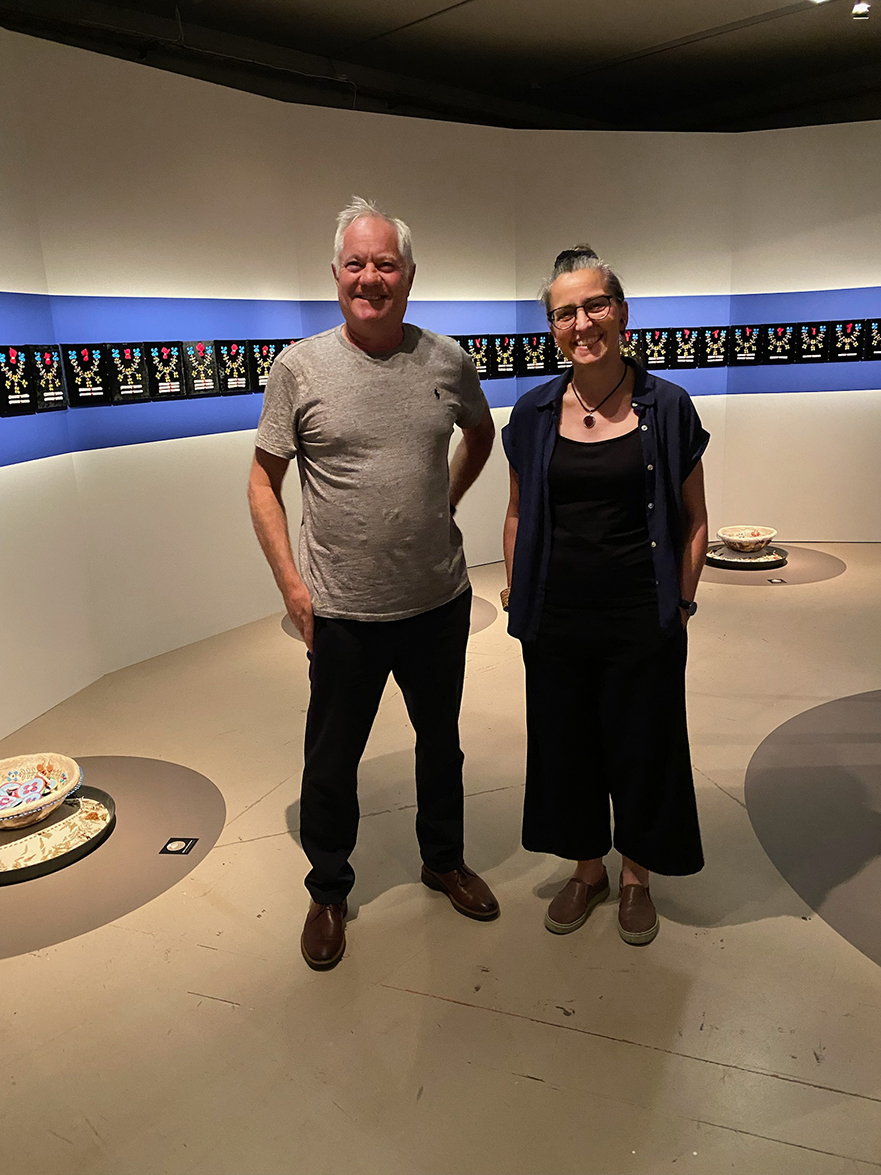 David Heffel, President of Heffel Gallery Ltd., and Heidrun (Runa) Löb, Director, NONAM, Zurich Switzerland.
David Heffel, President of Heffel Gallery Ltd., and Heidrun (Runa) Löb, Director, NONAM, Zurich Switzerland. 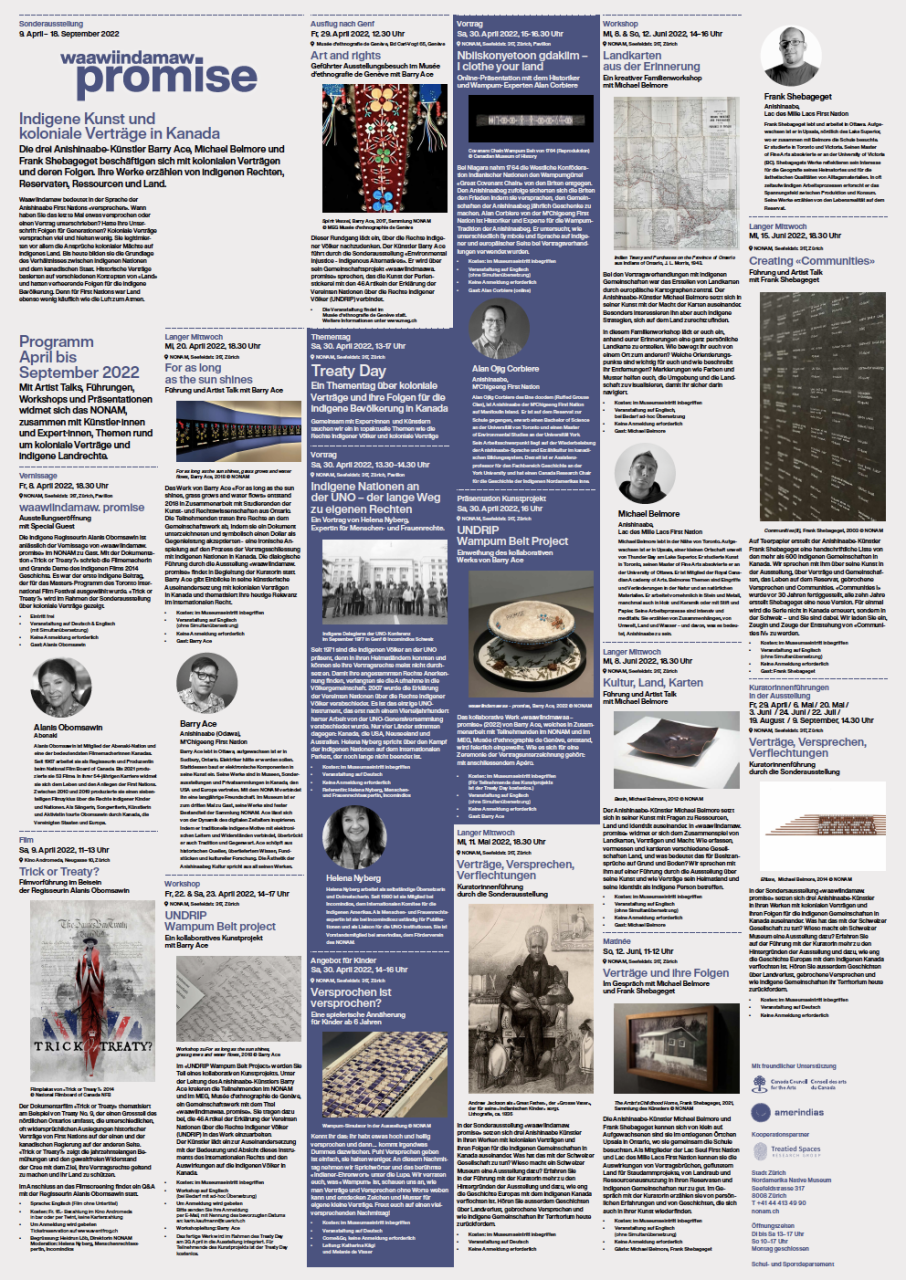 Exhibition Program (see PDF download in text).
Exhibition Program (see PDF download in text). 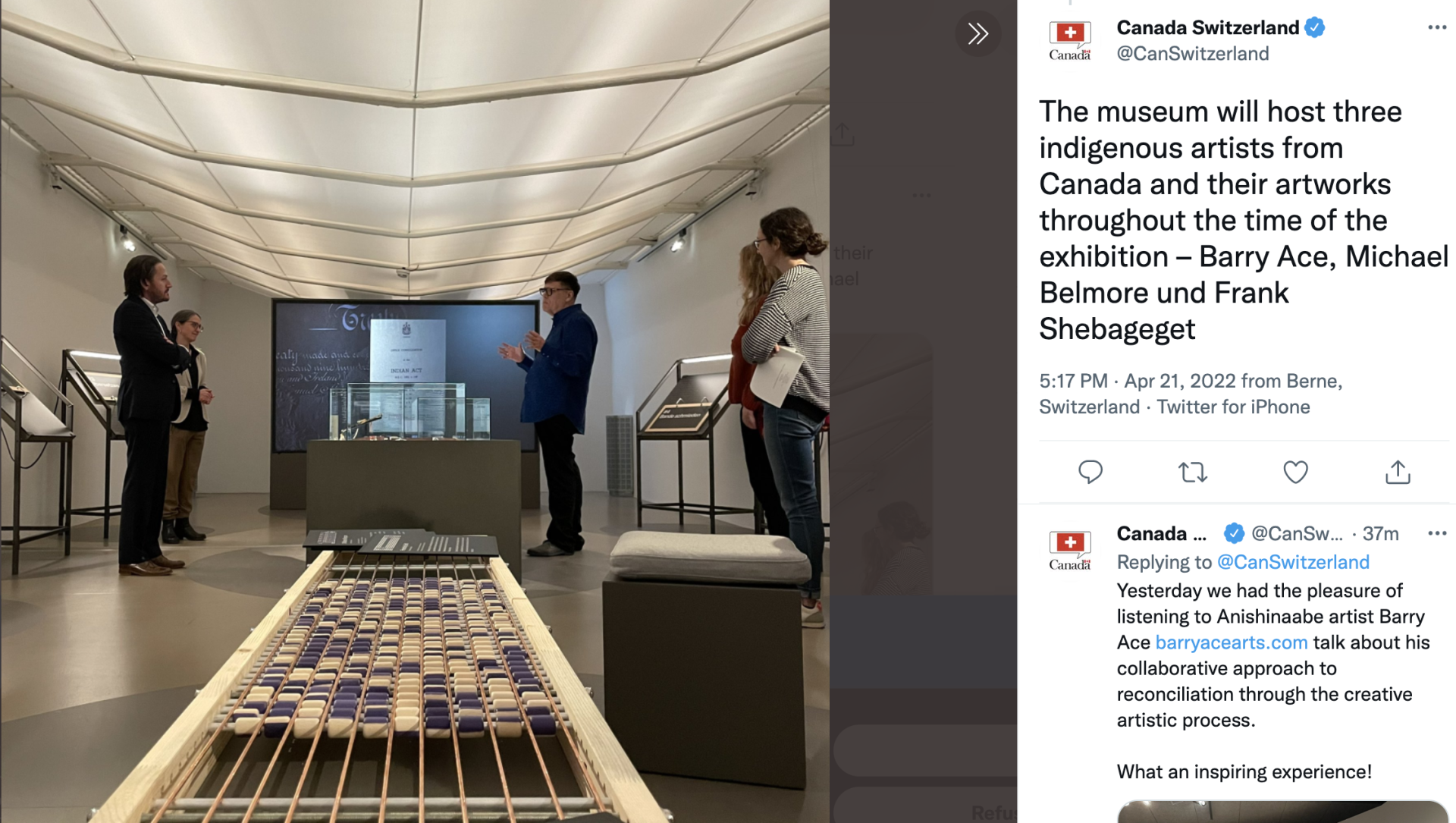 Exhibition tour with Philippe Genest, Counsellor (Political, Cultural, and Public Affairs) and Vice-Consul, Embassy of Canada (Bern, Switzerland). left
Exhibition tour with Philippe Genest, Counsellor (Political, Cultural, and Public Affairs) and Vice-Consul, Embassy of Canada (Bern, Switzerland). left 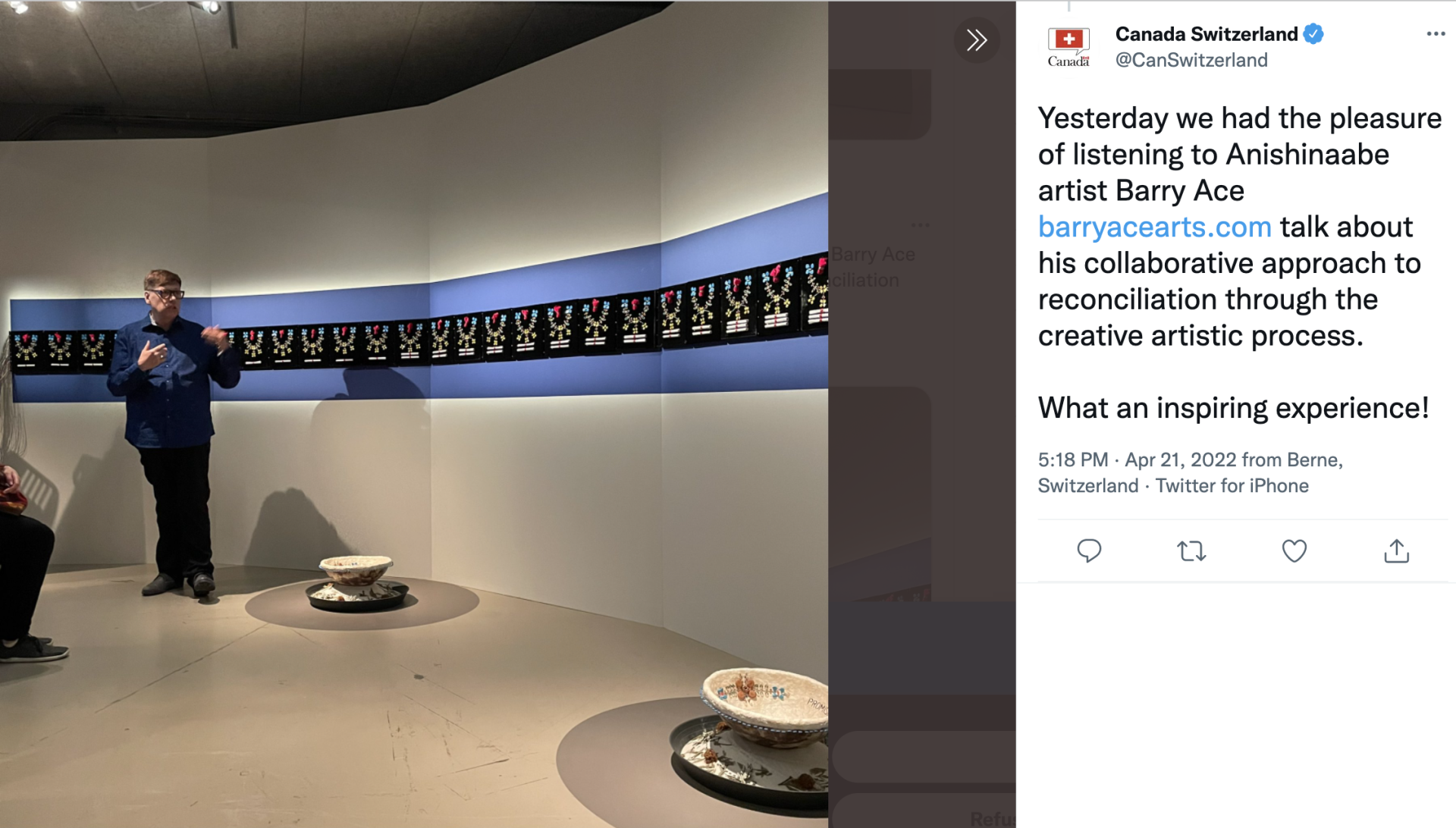 Barry Ace artist talk and exhibition tour with Philippe Genest, Counsellor (Political, Cultural, and Public Affairs) and Vice-Consul, Embassy of Canada (Bern, Switzerland).
Barry Ace artist talk and exhibition tour with Philippe Genest, Counsellor (Political, Cultural, and Public Affairs) and Vice-Consul, Embassy of Canada (Bern, Switzerland). 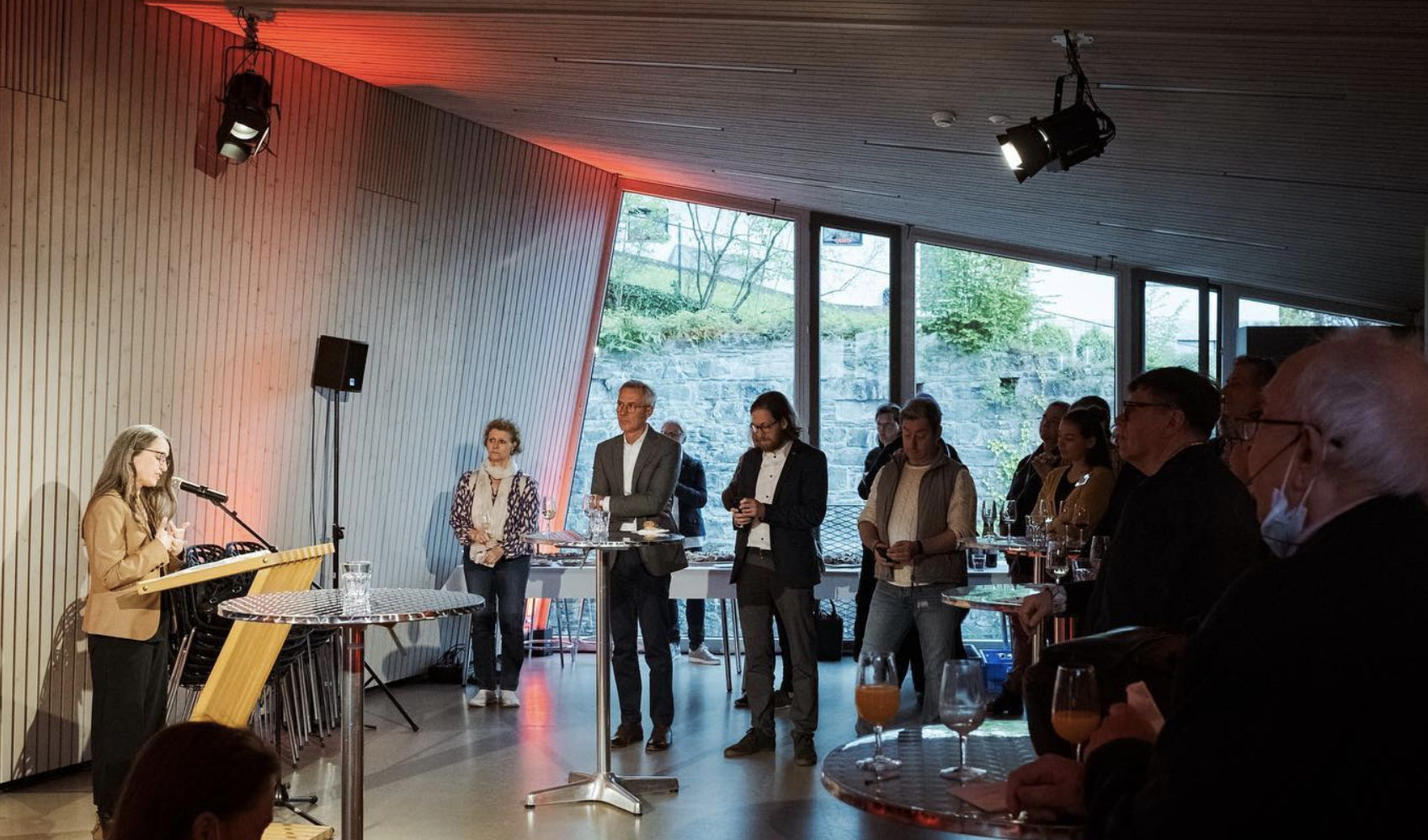 Heidrun (Runa) Löb, Director (NONAM), Treaty Day Welcome. April 30, 2022.Photo Courtesy of NONAM.
Heidrun (Runa) Löb, Director (NONAM), Treaty Day Welcome. April 30, 2022.Photo Courtesy of NONAM.  Heidrun (Runa) Löb, Director (NONAM), Patrick Wittmann (Canadian Ambassador, Switzerland and Liechtenstein) and Claude Järmann (NONAM). Treaty Day Welcome. Photo Courtesy of NONAM.
Heidrun (Runa) Löb, Director (NONAM), Patrick Wittmann (Canadian Ambassador, Switzerland and Liechtenstein) and Claude Järmann (NONAM). Treaty Day Welcome. Photo Courtesy of NONAM. 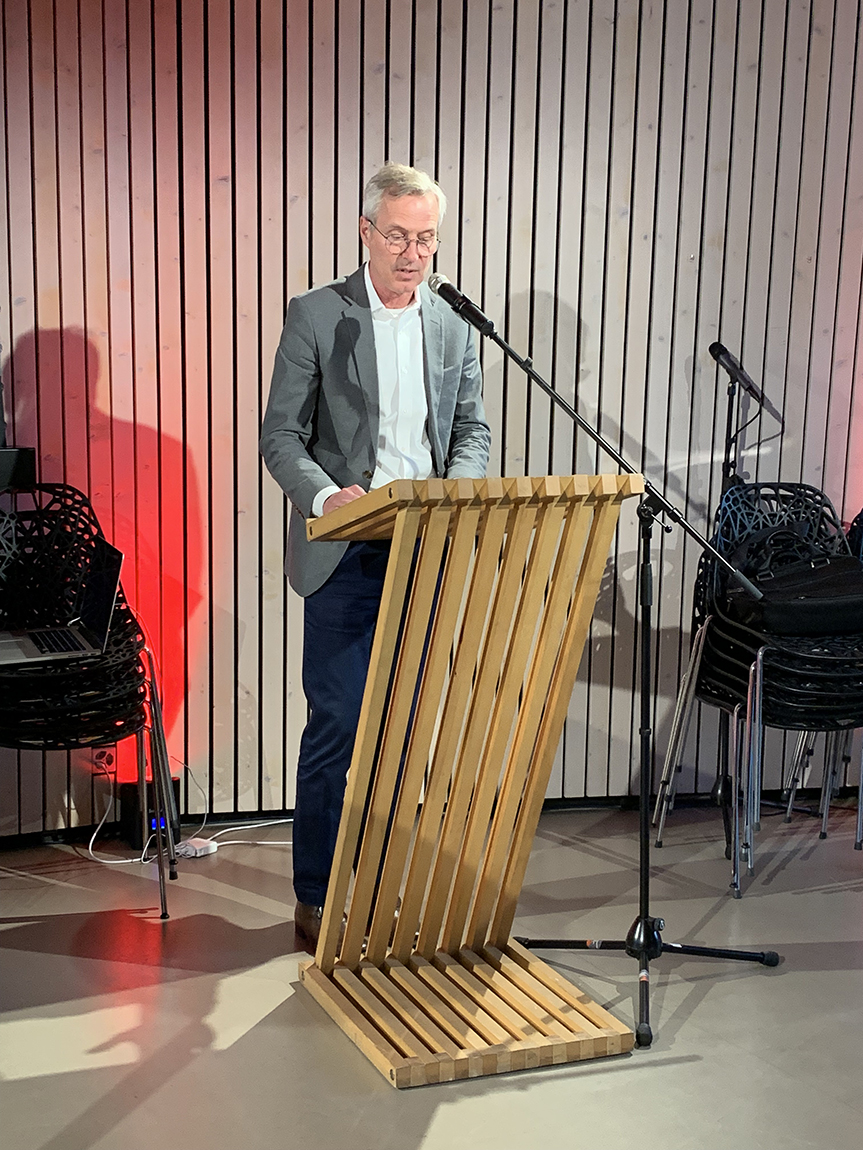 Patrick Wittmann, Canadian Ambassador, Switzerland and Liechtenstein. Welcoming Remarks Treaty Day, April 30, 2022 (NONAM). Photo Courtesy of NONAM.
Patrick Wittmann, Canadian Ambassador, Switzerland and Liechtenstein. Welcoming Remarks Treaty Day, April 30, 2022 (NONAM). Photo Courtesy of NONAM. 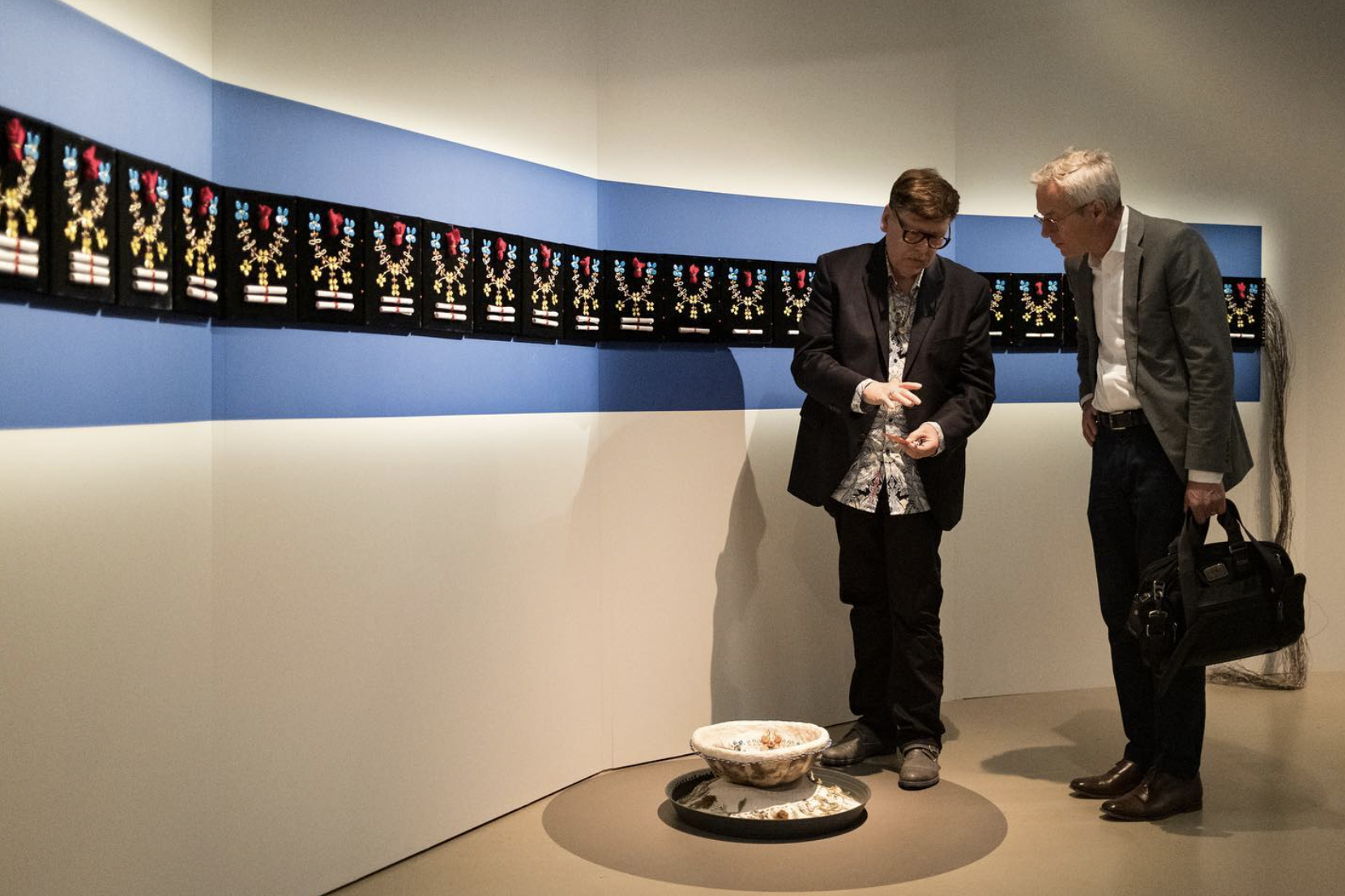 Barry Ace (Artist) and Patrick Wittmann, Canadian Ambassador, Switzerland and Liechtenstein. Exhibition Tour - Treaty Day, April 30, 2022 (NONAM). Photo Courtesy of NONAM.
Barry Ace (Artist) and Patrick Wittmann, Canadian Ambassador, Switzerland and Liechtenstein. Exhibition Tour - Treaty Day, April 30, 2022 (NONAM). Photo Courtesy of NONAM. 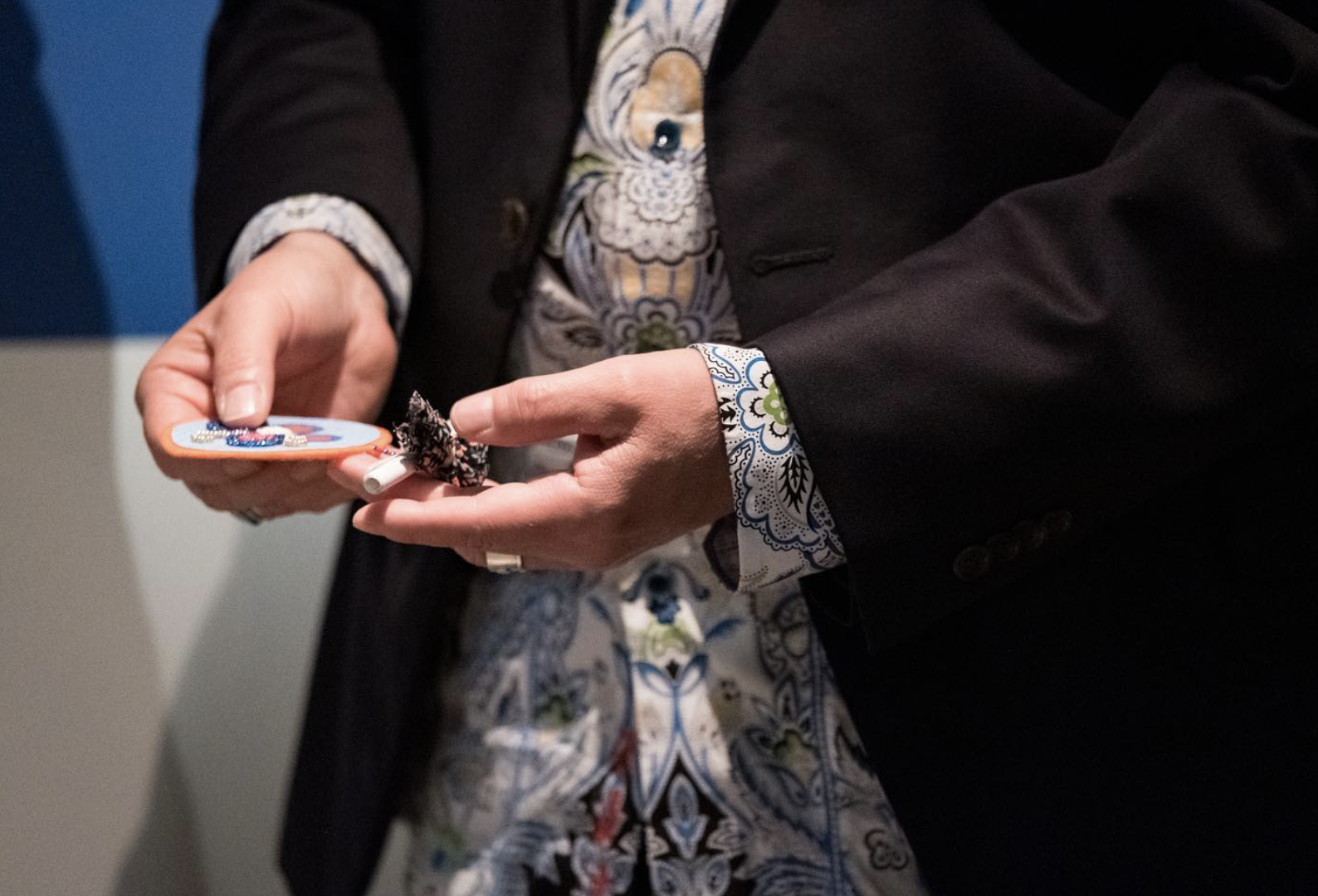 waawiindmawaa – promise (to promise something to somebody) (detail) (2022). Photo Courtesy of NONAM.
waawiindmawaa – promise (to promise something to somebody) (detail) (2022). Photo Courtesy of NONAM.  Barry Ace, Artist Talk and Exhibition Tour - Treaty Day, April 30, 2022 (NONAM). Photo Courtesy of NONAM.
Barry Ace, Artist Talk and Exhibition Tour - Treaty Day, April 30, 2022 (NONAM). Photo Courtesy of NONAM. 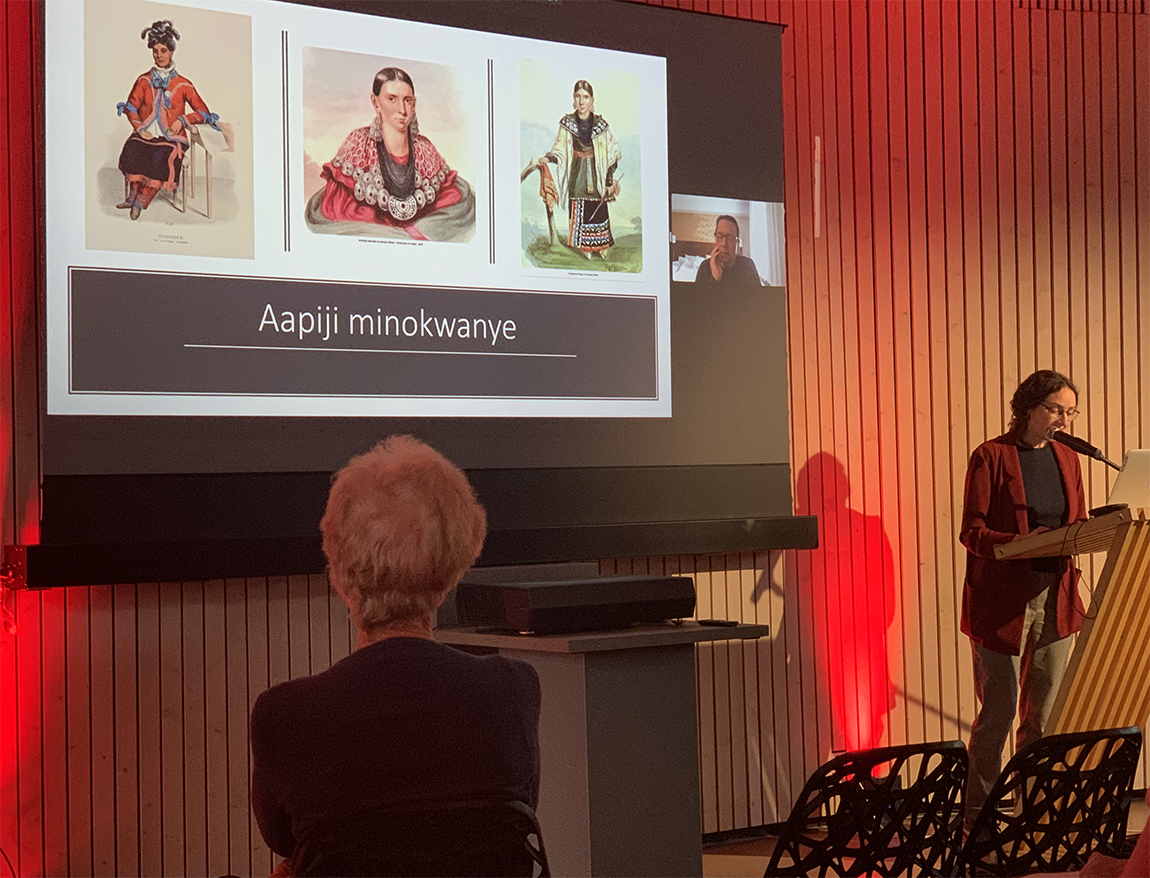 Dr. Alan Corbiere, Assistant Professor, Canada Research Chair in Indigenous History of North America, York University (Toronto) - Wampum Presentation: Nbiiskonyetoon gdakiim - I clothe your land. Treaty Day, April 30, 2022 (NONAM). Introduction by Karin Kaufmann.
Dr. Alan Corbiere, Assistant Professor, Canada Research Chair in Indigenous History of North America, York University (Toronto) - Wampum Presentation: Nbiiskonyetoon gdakiim - I clothe your land. Treaty Day, April 30, 2022 (NONAM). Introduction by Karin Kaufmann. 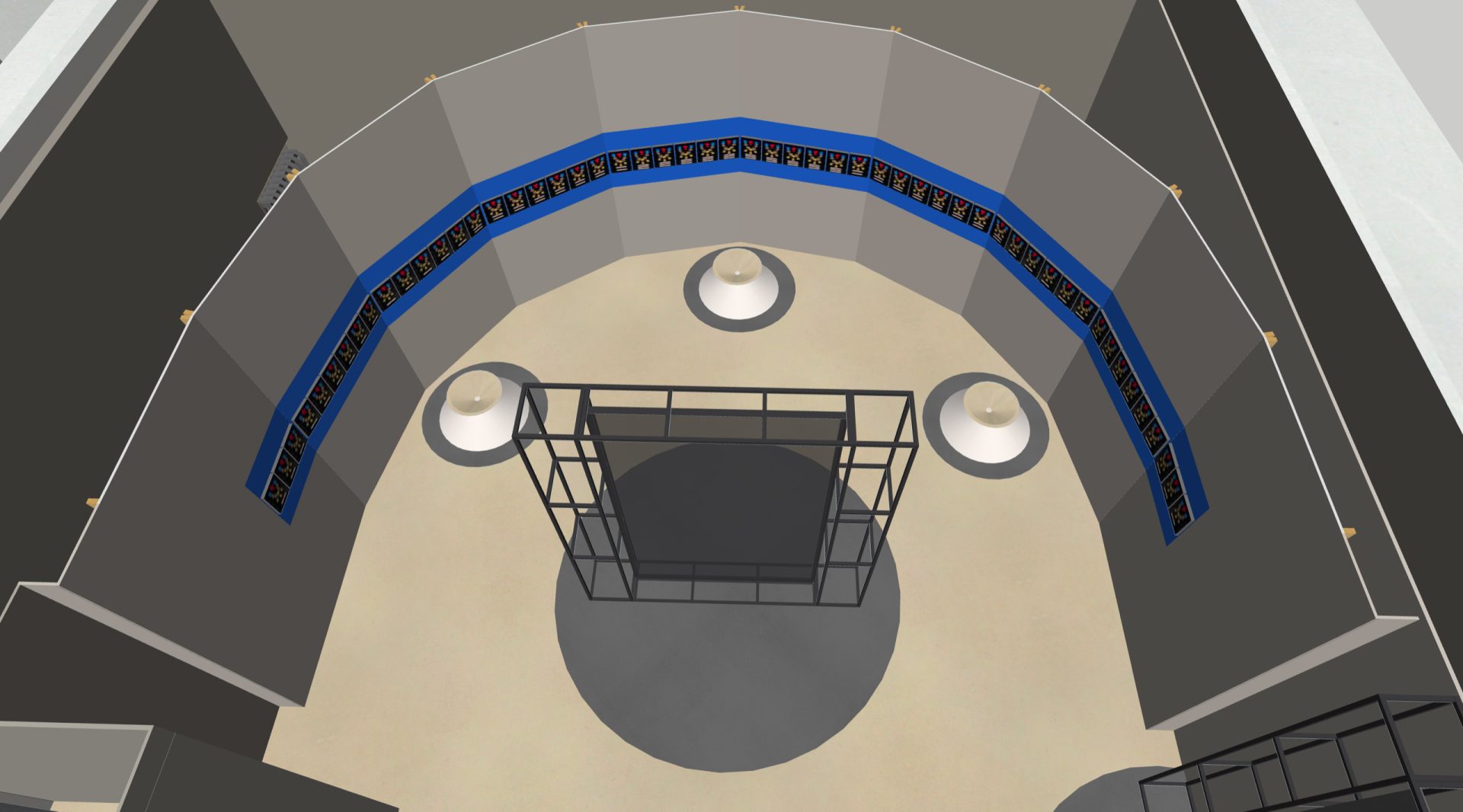 Installation Rendering: Markus Roost Design. Courtesy of NONAM.
Installation Rendering: Markus Roost Design. Courtesy of NONAM. 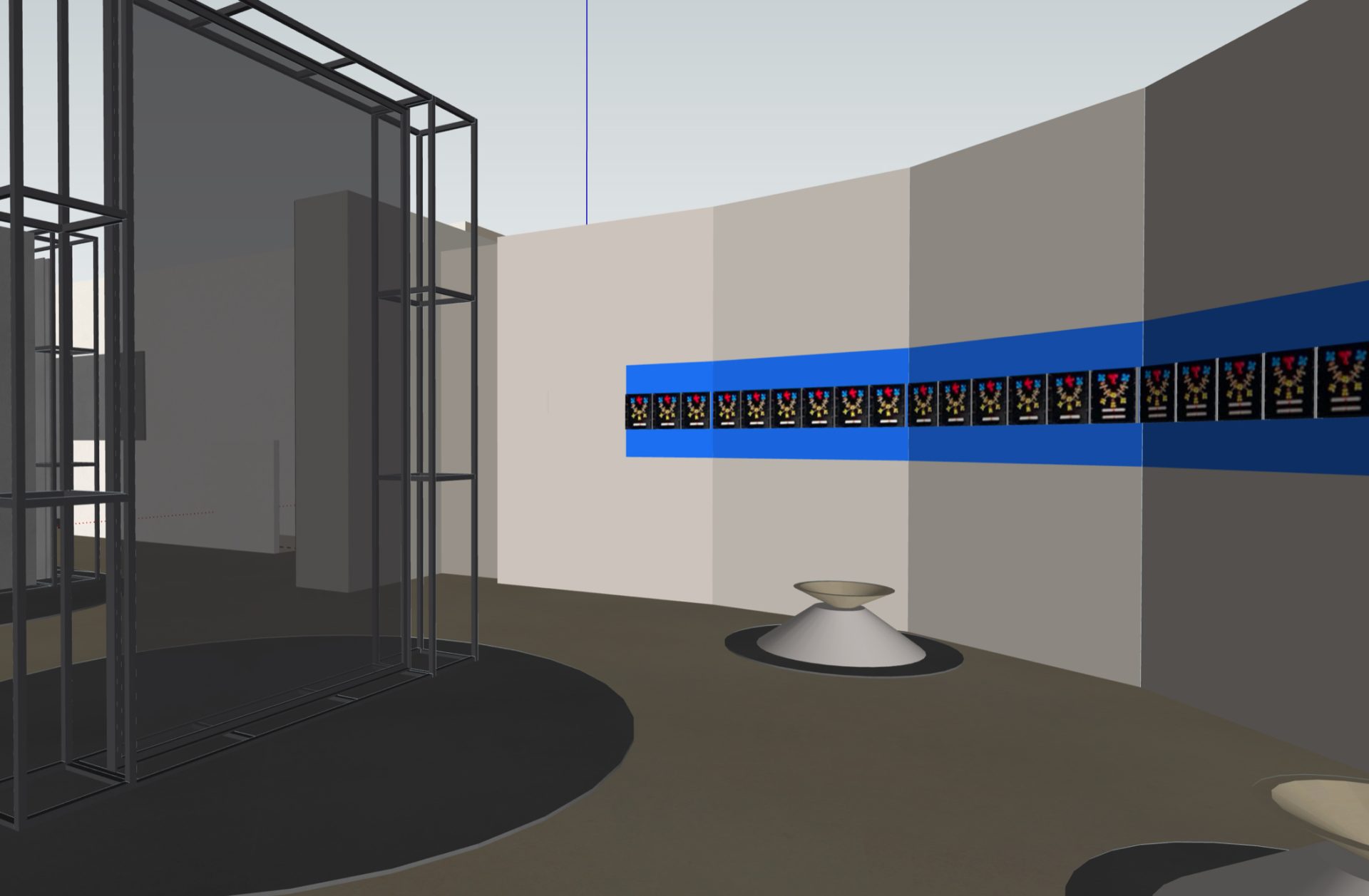 Installation Rendering. Markus Roost Design. Courtesy NONAM.
Installation Rendering. Markus Roost Design. Courtesy NONAM. 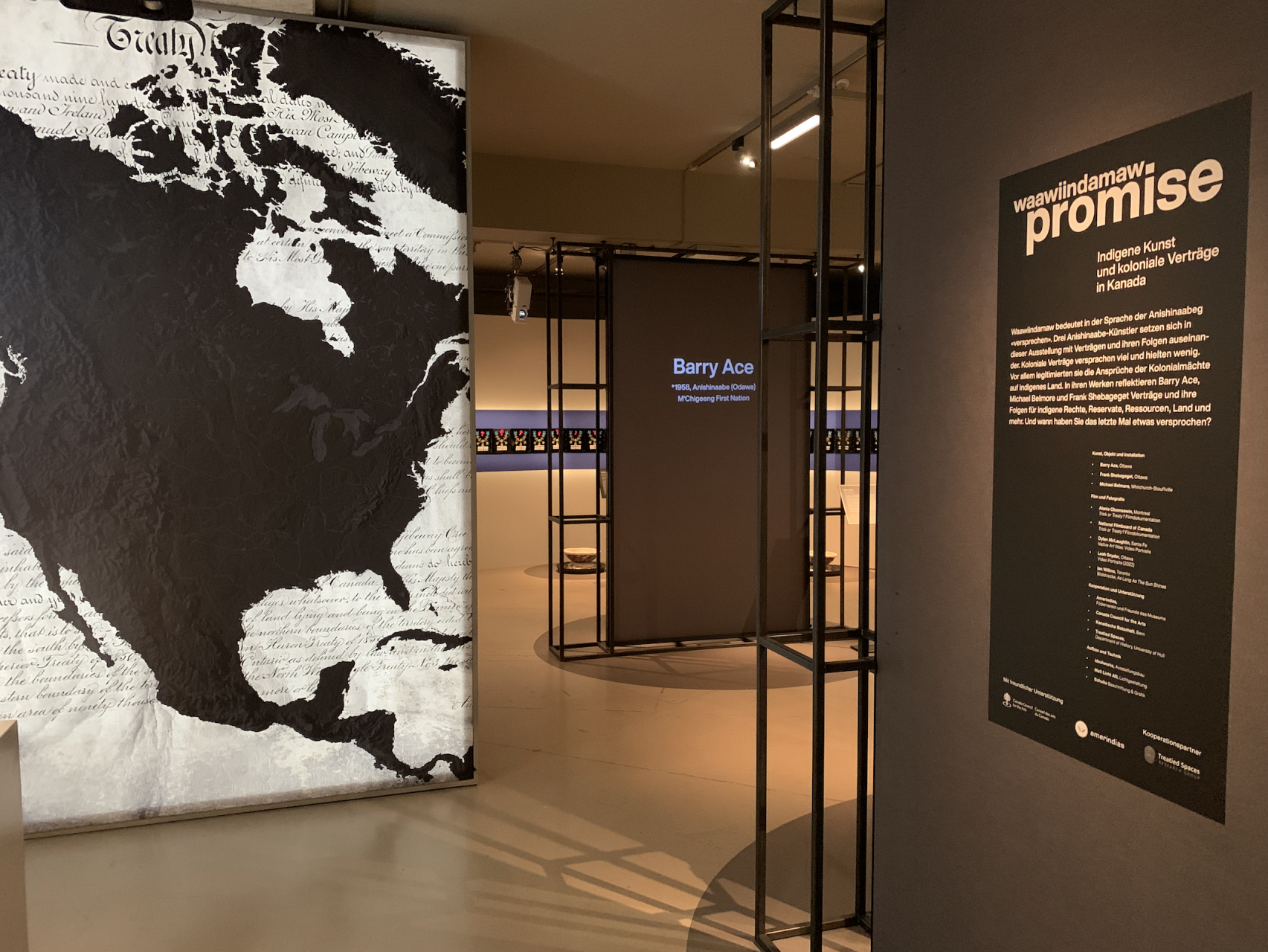 wāwīndamaw – promise: Indigenous Art and Colonial Treaties in Canada.
wāwīndamaw – promise: Indigenous Art and Colonial Treaties in Canada.  94 Collaborators who worked on For as long as the sun shines, the grass grows and the river flows (2018) (University of Windsor, Windsor, Ontario).
94 Collaborators who worked on For as long as the sun shines, the grass grows and the river flows (2018) (University of Windsor, Windsor, Ontario). 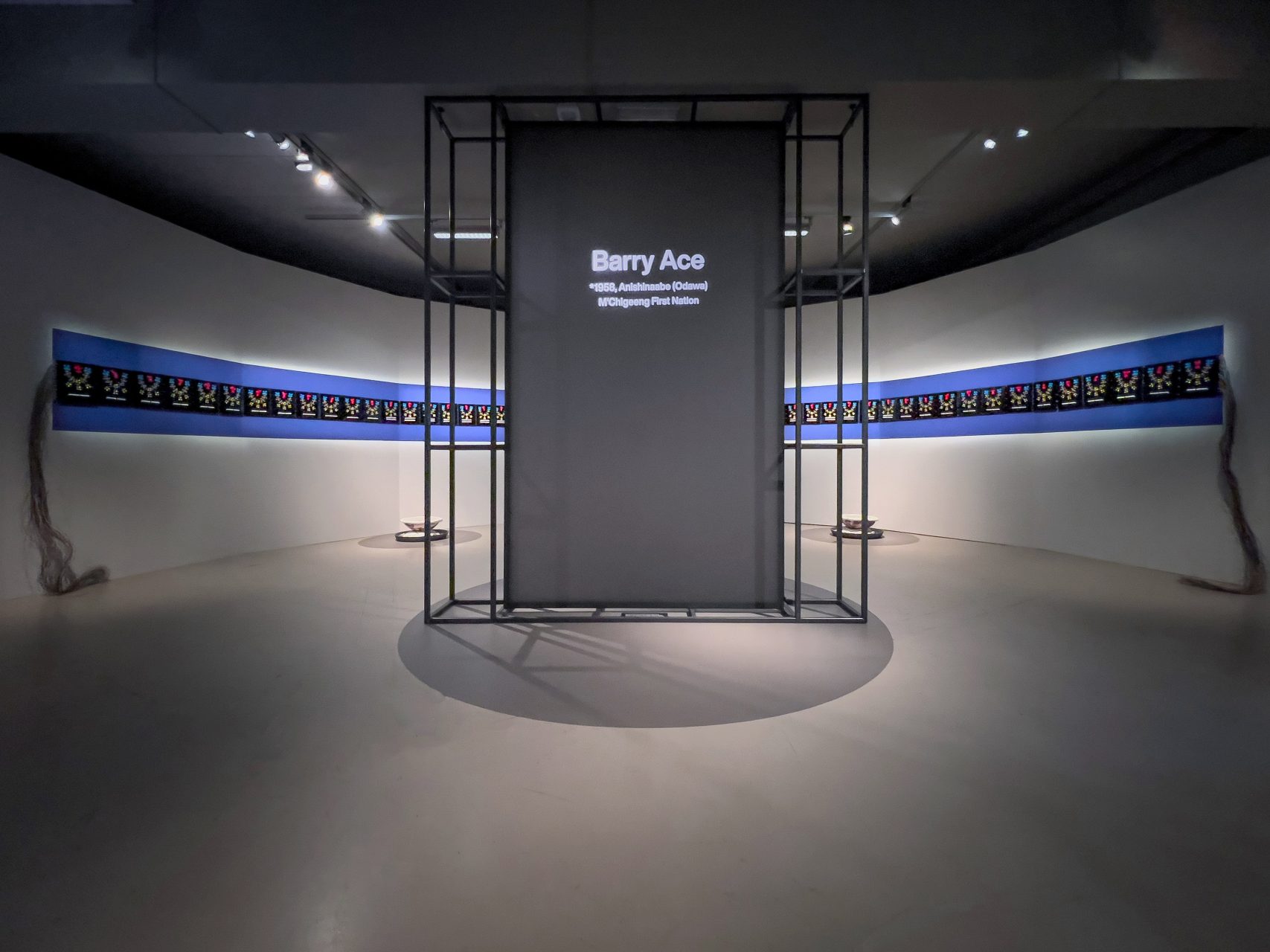 For as long as the sun shines, the grass grows and the river flows (2018) and waawiindmawaa – promise (to promise something to somebody) (2022). Collection of the Artist. Courtesy of NONAM.
For as long as the sun shines, the grass grows and the river flows (2018) and waawiindmawaa – promise (to promise something to somebody) (2022). Collection of the Artist. Courtesy of NONAM. 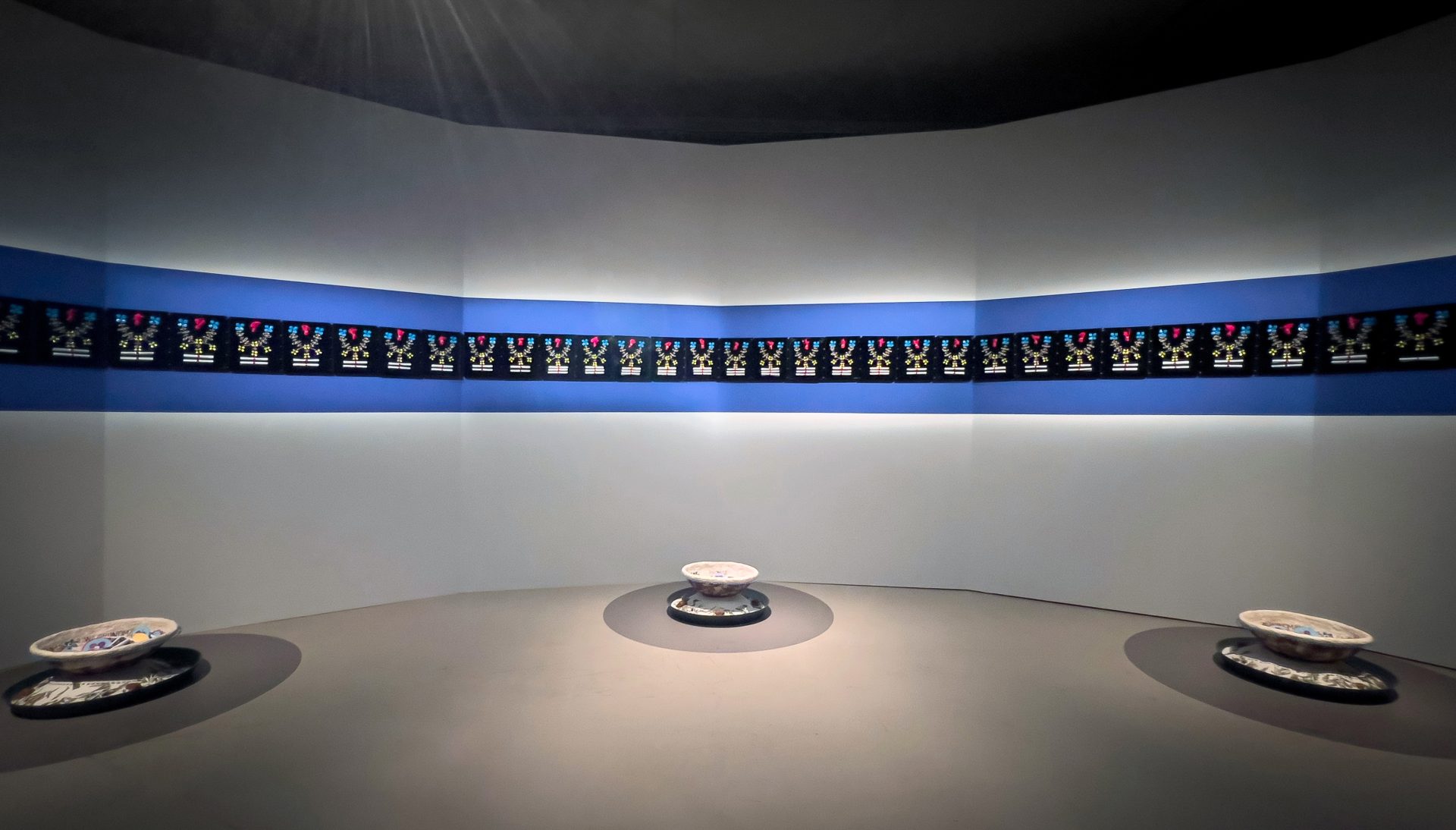 For as long as the sun shines, the grass grows and the river flows (2018) and waawiindmawaa – promise (to promise something to somebody) (2022). Collection of the Artist. Courtesy of NONAM.
For as long as the sun shines, the grass grows and the river flows (2018) and waawiindmawaa – promise (to promise something to somebody) (2022). Collection of the Artist. Courtesy of NONAM. 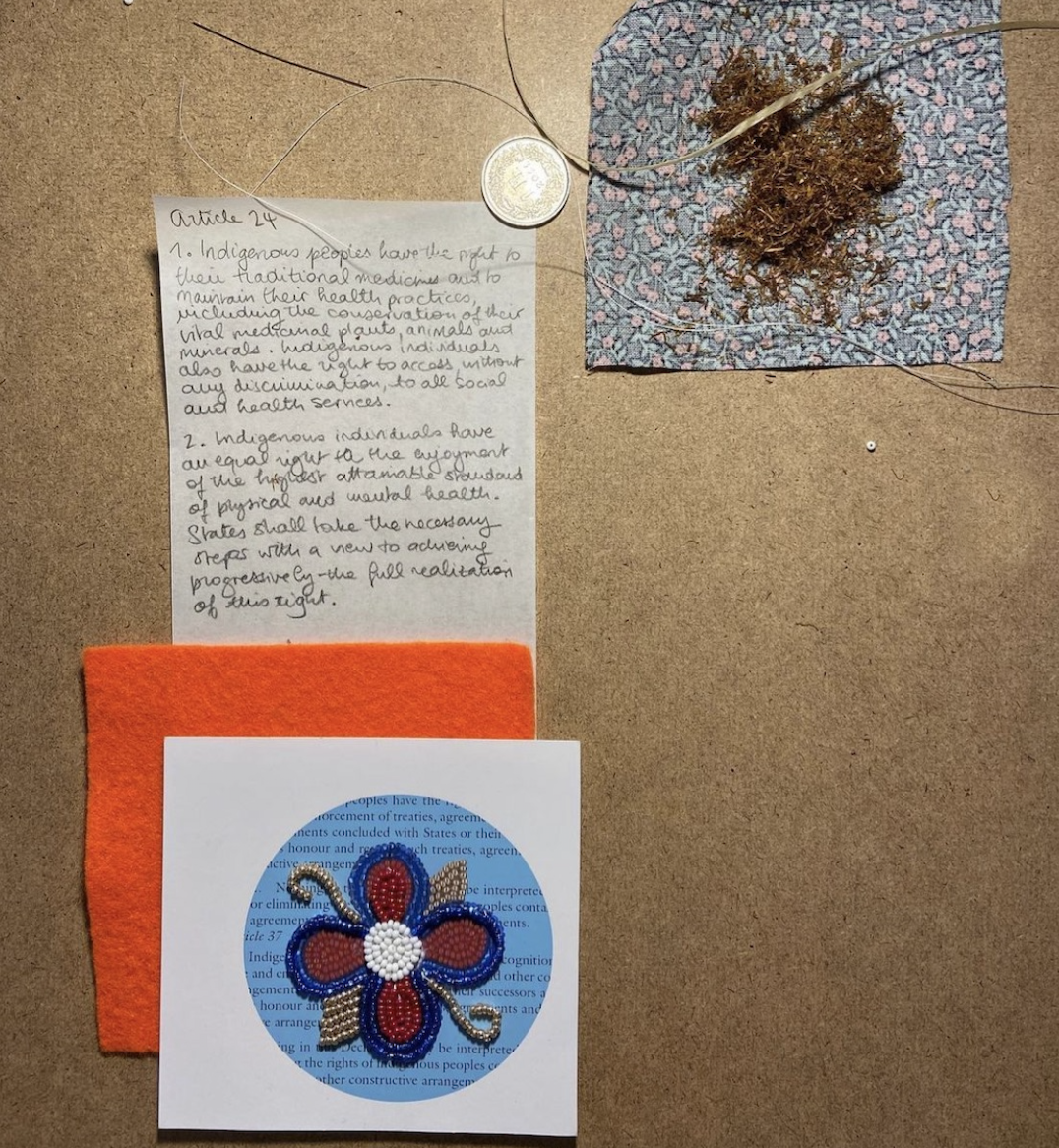 waawiindmawaa – promise (to promise something to somebody) (2022) #24 of 46 collaborative beaded UNDRIP Articles placed in each vessel with vellum scroll and tobacco tie.
waawiindmawaa – promise (to promise something to somebody) (2022) #24 of 46 collaborative beaded UNDRIP Articles placed in each vessel with vellum scroll and tobacco tie. 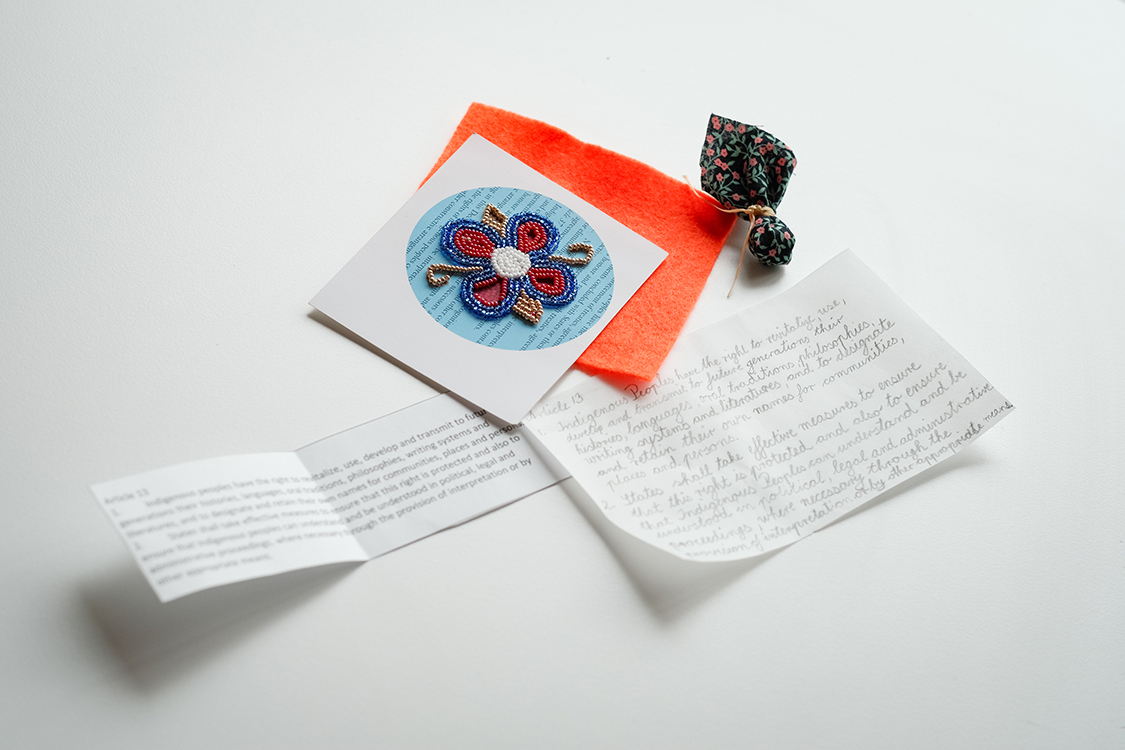 Photo Courtesy: NONAM / Jonathan Labusch
Photo Courtesy: NONAM / Jonathan Labusch  waawiindmawaa – promise (to promise something to somebody) (detail 1 of 3 vessels) (2022).
waawiindmawaa – promise (to promise something to somebody) (detail 1 of 3 vessels) (2022). 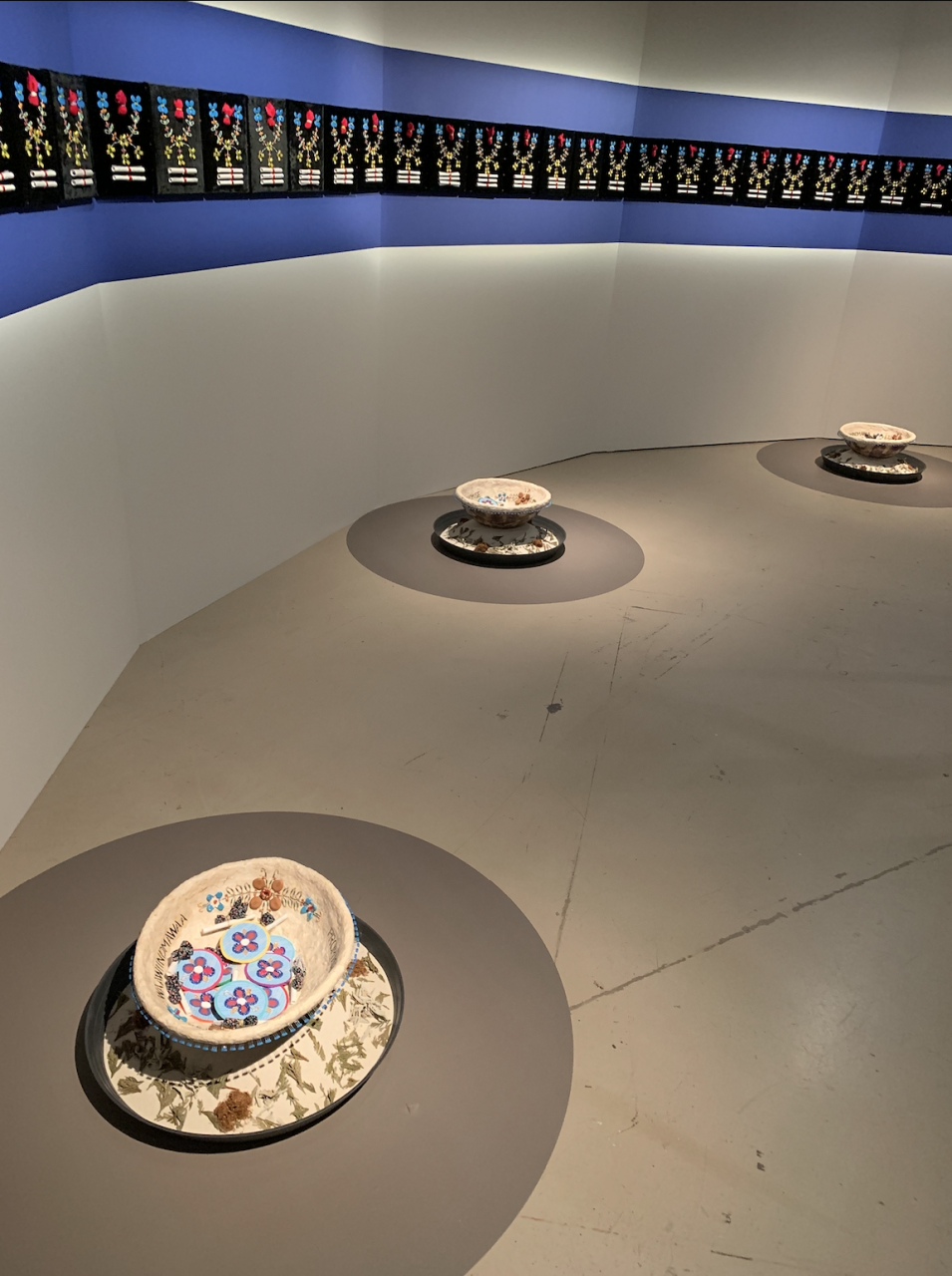 For as long as the sun shines, the grass grows and the river flows (2018) and waawiindmawaa – promise (to promise something to somebody) (2022).
For as long as the sun shines, the grass grows and the river flows (2018) and waawiindmawaa – promise (to promise something to somebody) (2022). 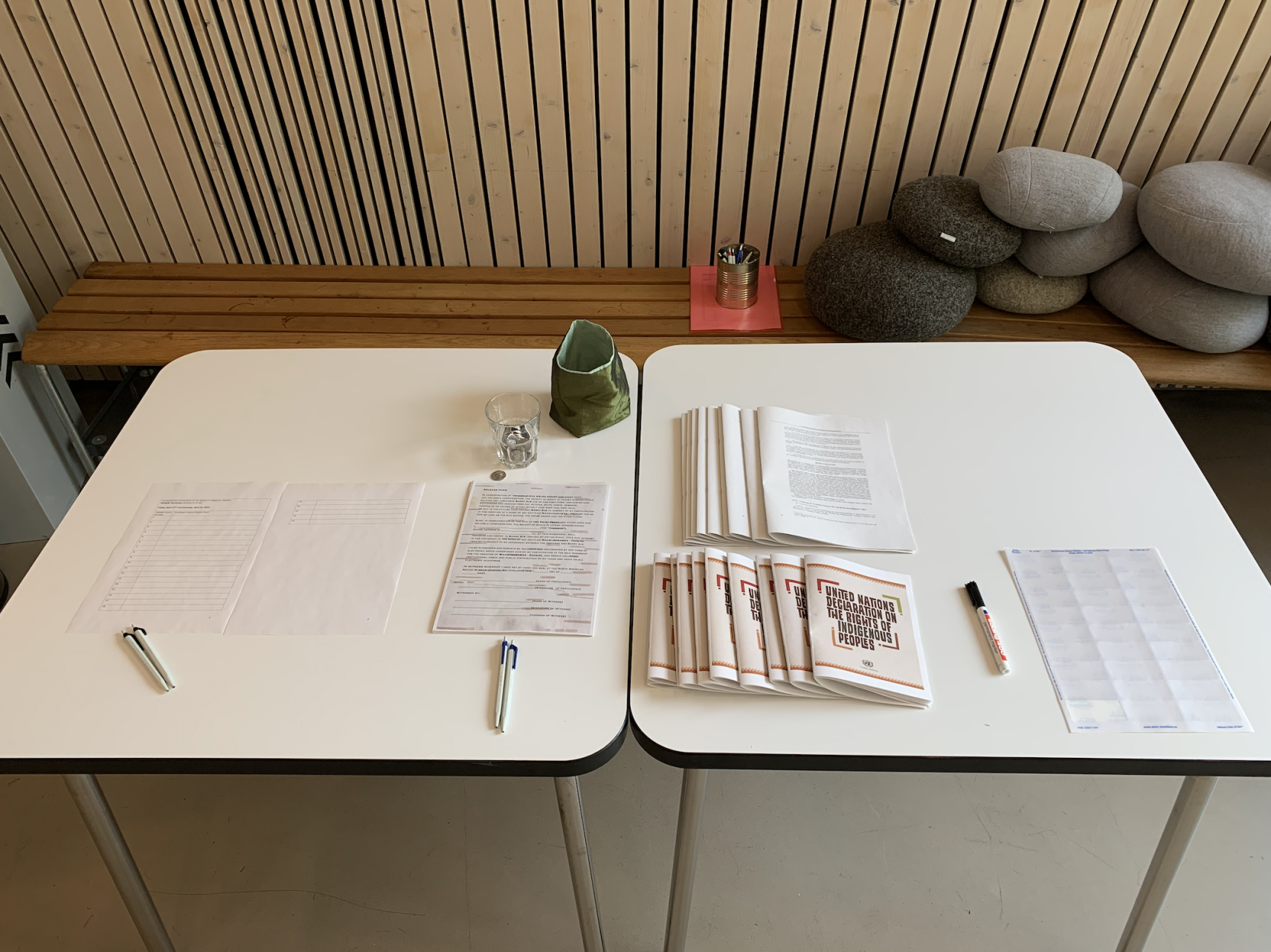 waawiindmawaa – promise (to promise something to somebody) workshop sign-in table (NONAM, Zurich)
waawiindmawaa – promise (to promise something to somebody) workshop sign-in table (NONAM, Zurich)  waawiindmawaa – promise (to promise something to somebody) workshop participants working on medallions and reading UNDRIP Articles (NONAM, Zurich). April 22, 2022.
waawiindmawaa – promise (to promise something to somebody) workshop participants working on medallions and reading UNDRIP Articles (NONAM, Zurich). April 22, 2022. 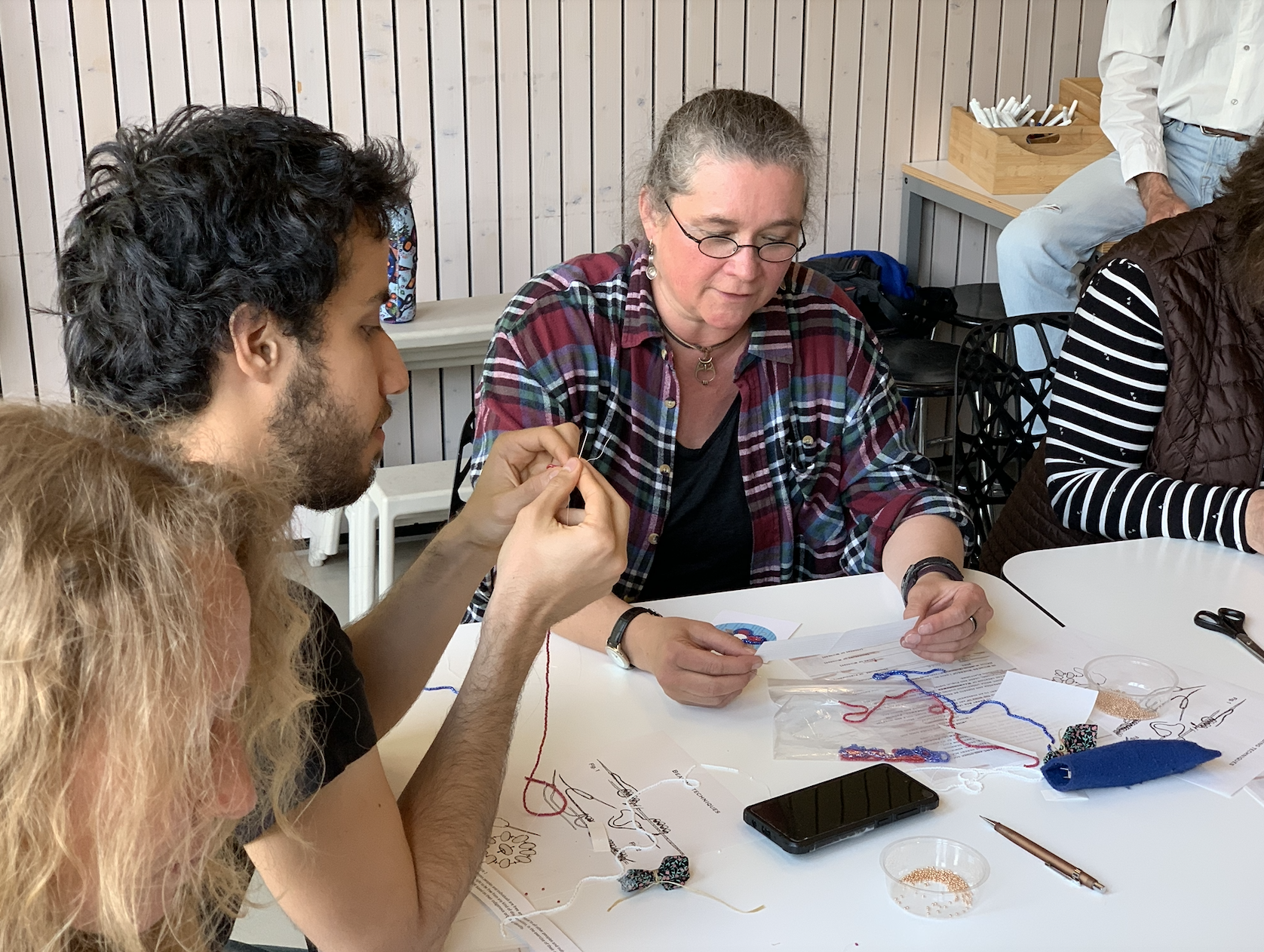 waawiindmawaa – promise (to promise something to somebody) workshop participants working on medallions and reading UNDRIP Articles (NONAM, Zurich). April 22, 2022.
waawiindmawaa – promise (to promise something to somebody) workshop participants working on medallions and reading UNDRIP Articles (NONAM, Zurich). April 22, 2022. 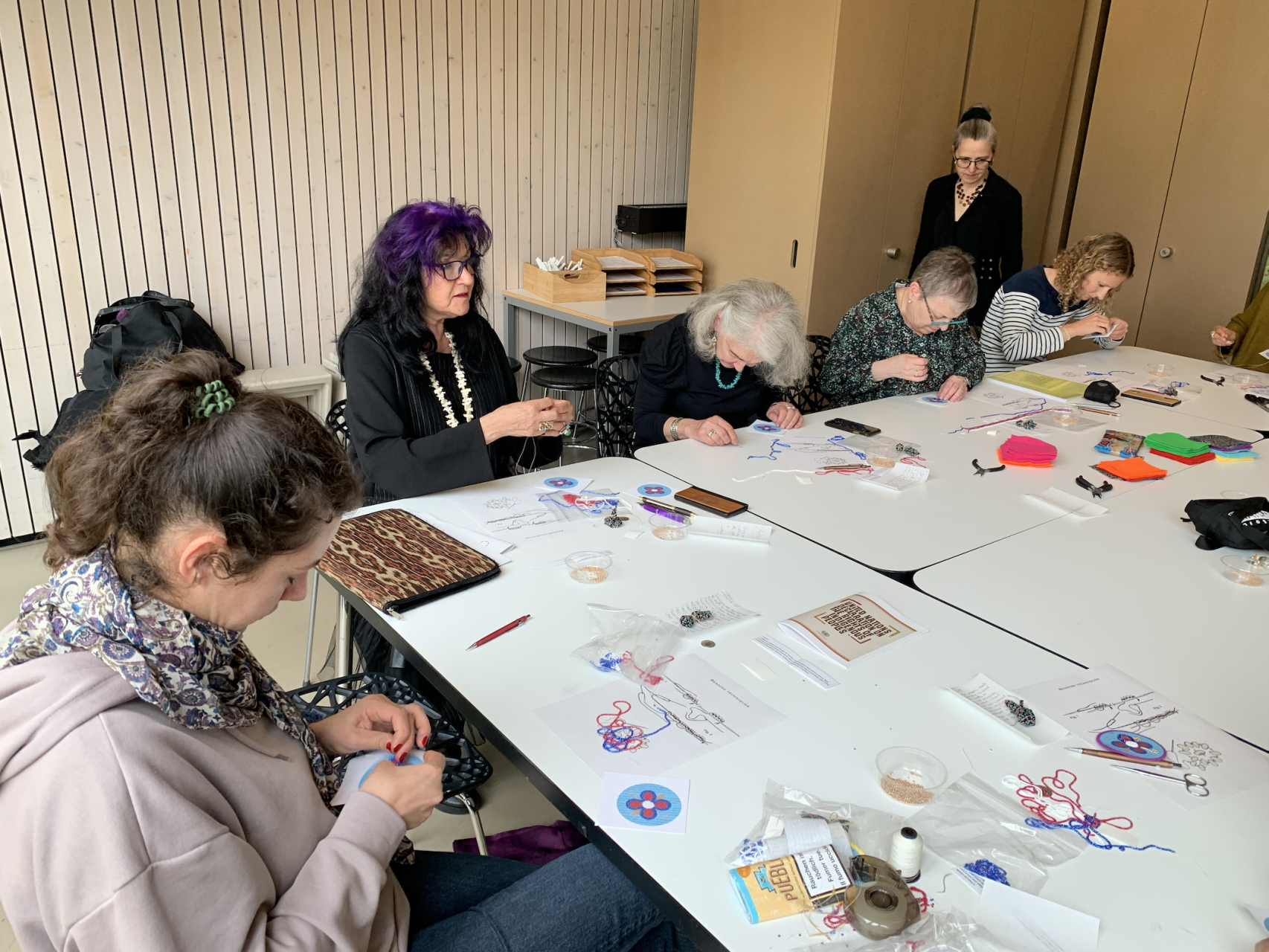 waawiindmawaa – promise (to promise something to somebody) workshop participants working on medallions and reading UNDRIP Articles (NONAM, Zurich). April 23, 2022.
waawiindmawaa – promise (to promise something to somebody) workshop participants working on medallions and reading UNDRIP Articles (NONAM, Zurich). April 23, 2022. 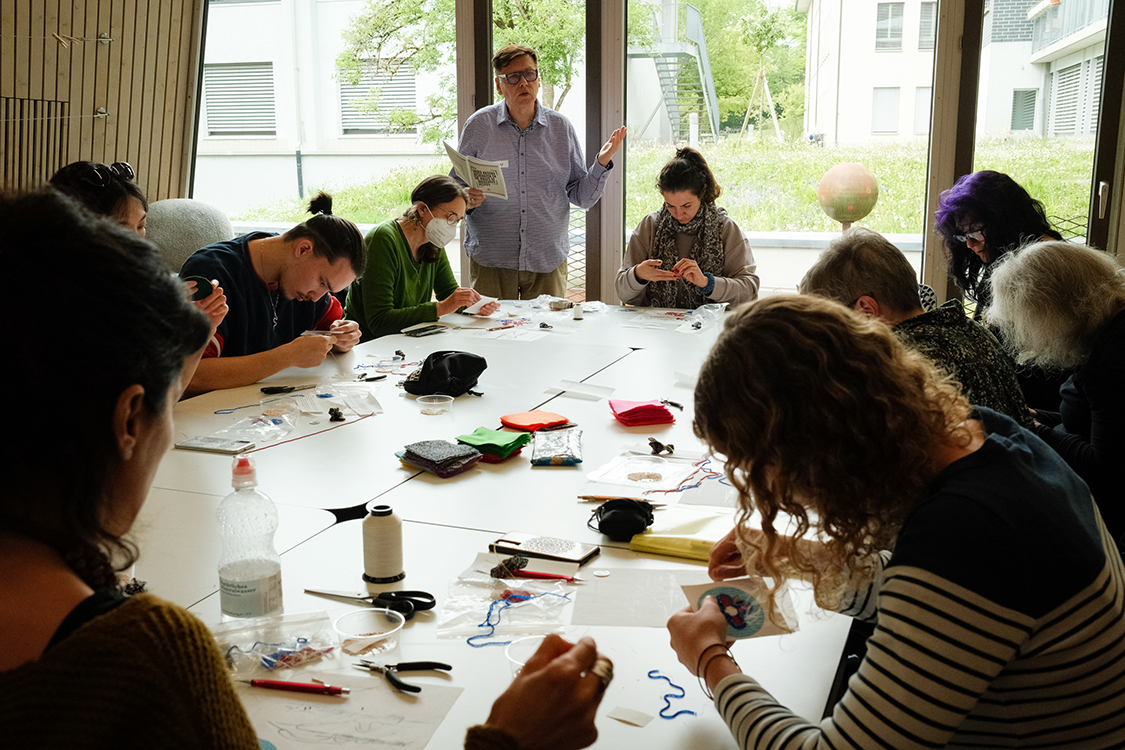 waawiindmawaa – promise (to promise something to somebody) workshop (NONAM, Zurich). April 23, 2022. Photo Courtesy: NONAM / Jonathan Labusch
waawiindmawaa – promise (to promise something to somebody) workshop (NONAM, Zurich). April 23, 2022. Photo Courtesy: NONAM / Jonathan Labusch 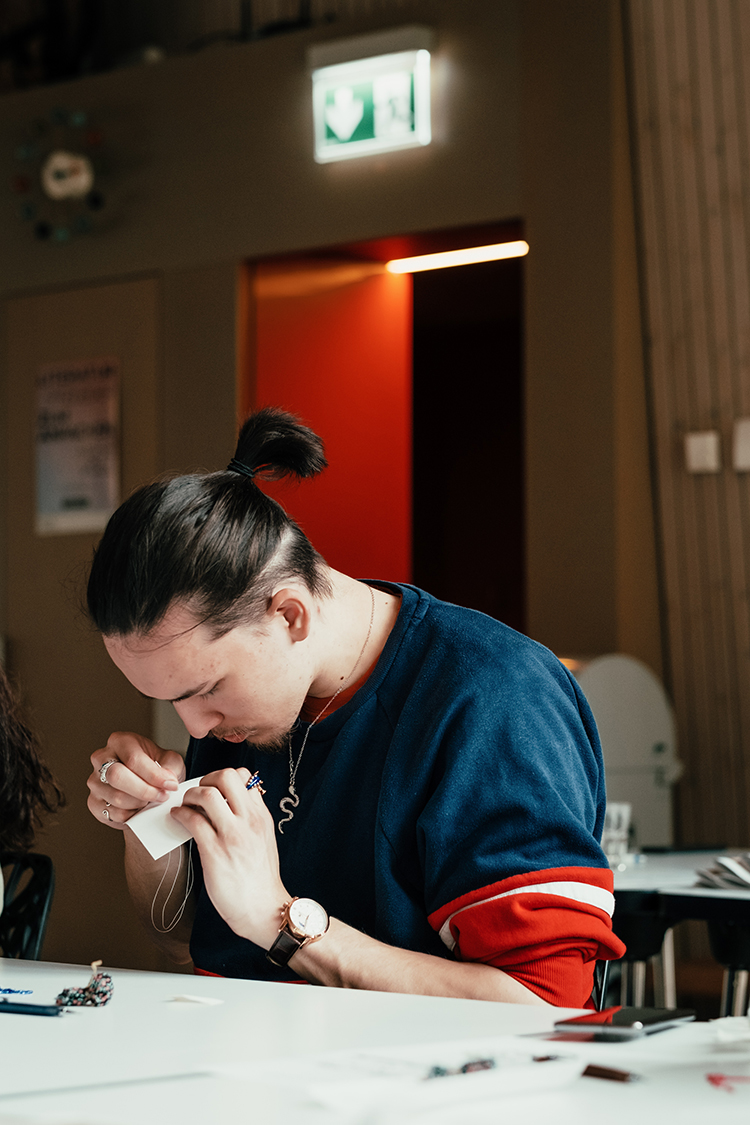 Photo Courtesy: NONAM / Jonathan Labusch
Photo Courtesy: NONAM / Jonathan Labusch 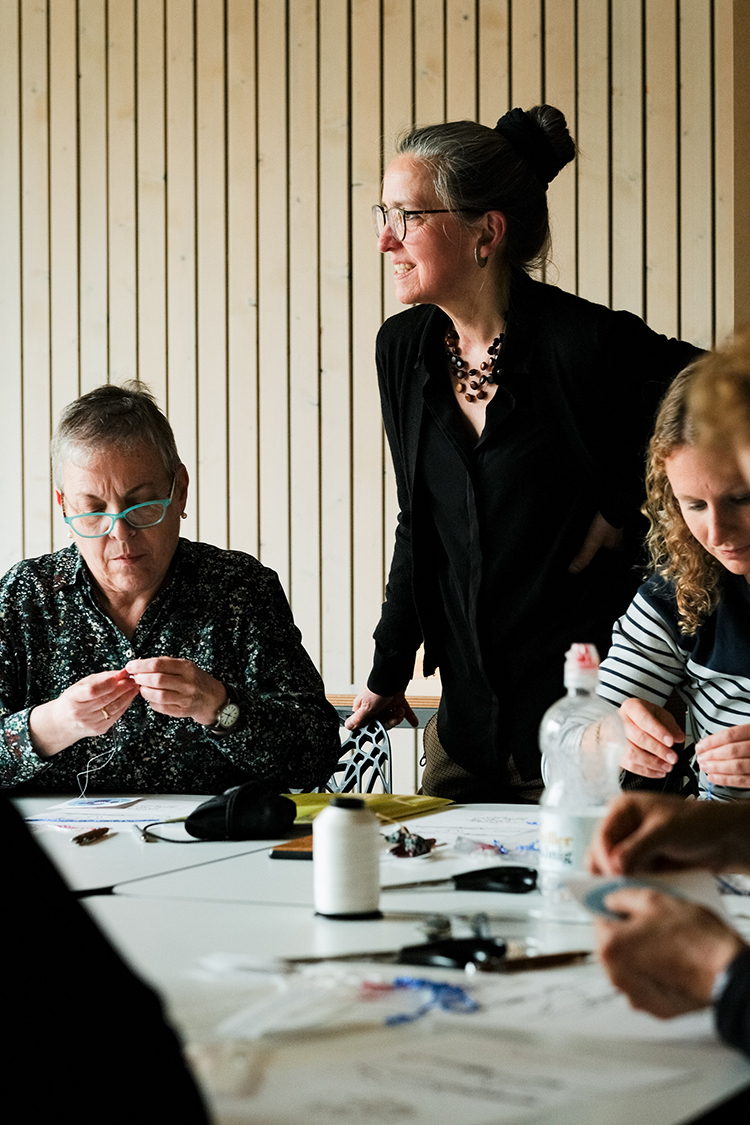 Photo Courtesy: NONAM / Jonathan Labusch
Photo Courtesy: NONAM / Jonathan Labusch 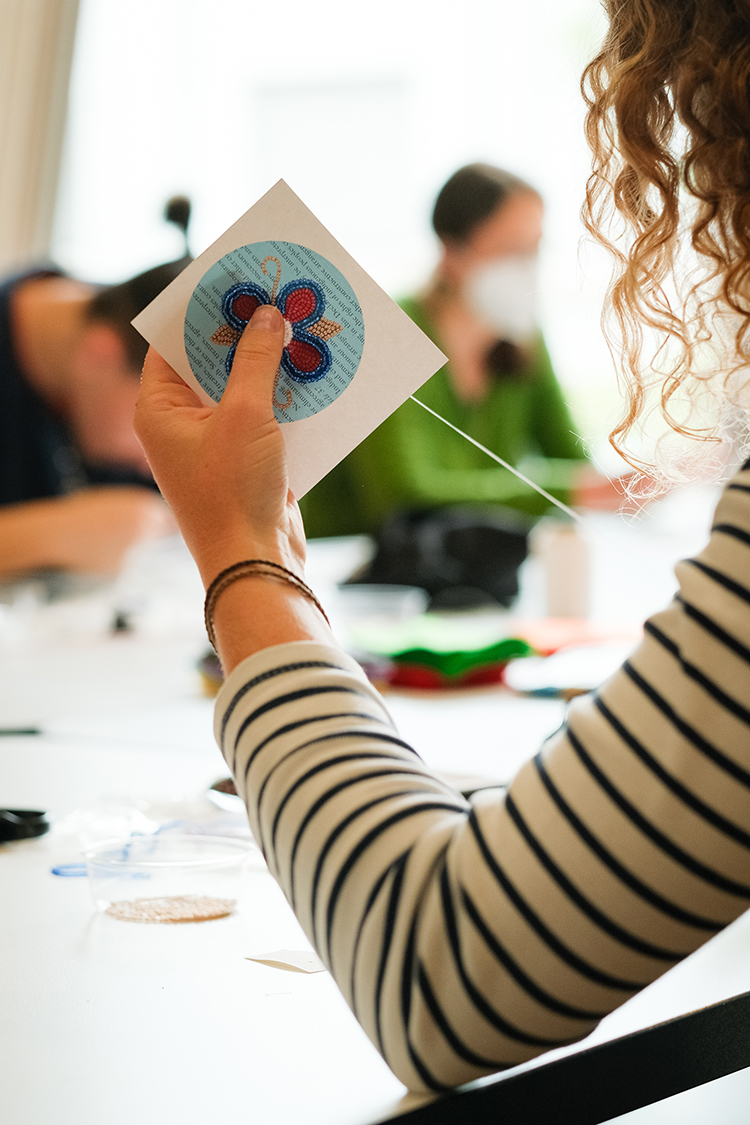 Photo Courtesy: NONAM / Jonathan Labusch
Photo Courtesy: NONAM / Jonathan Labusch 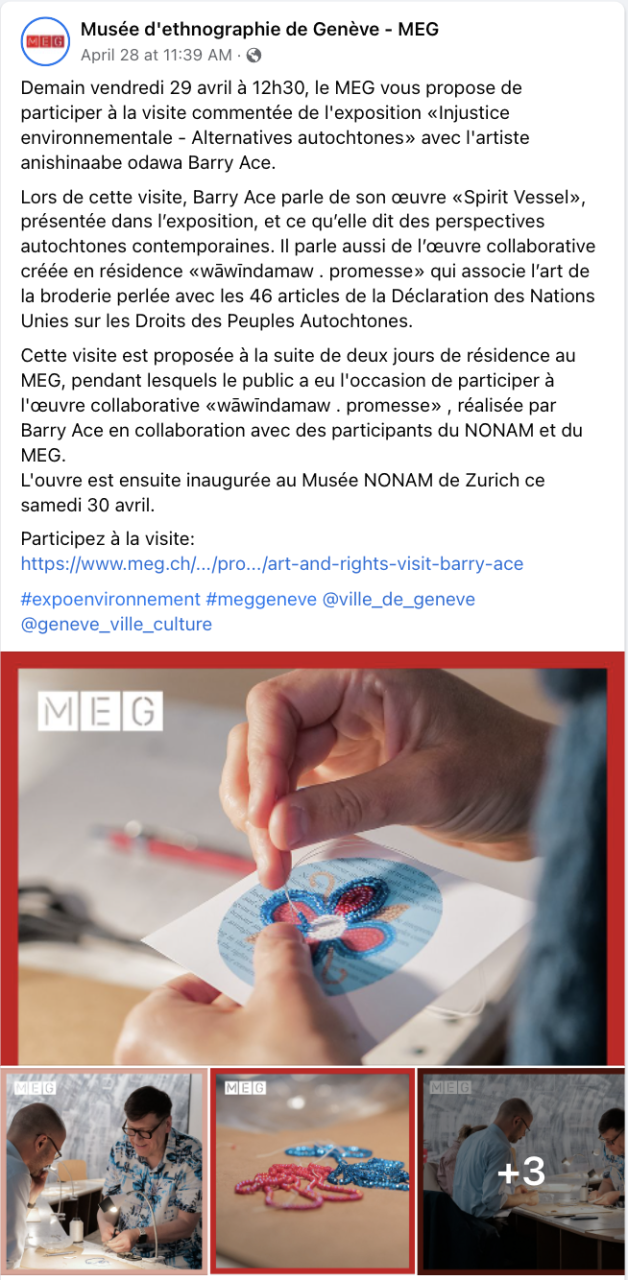 MEG (Geneva) - Workshops
MEG (Geneva) - Workshops 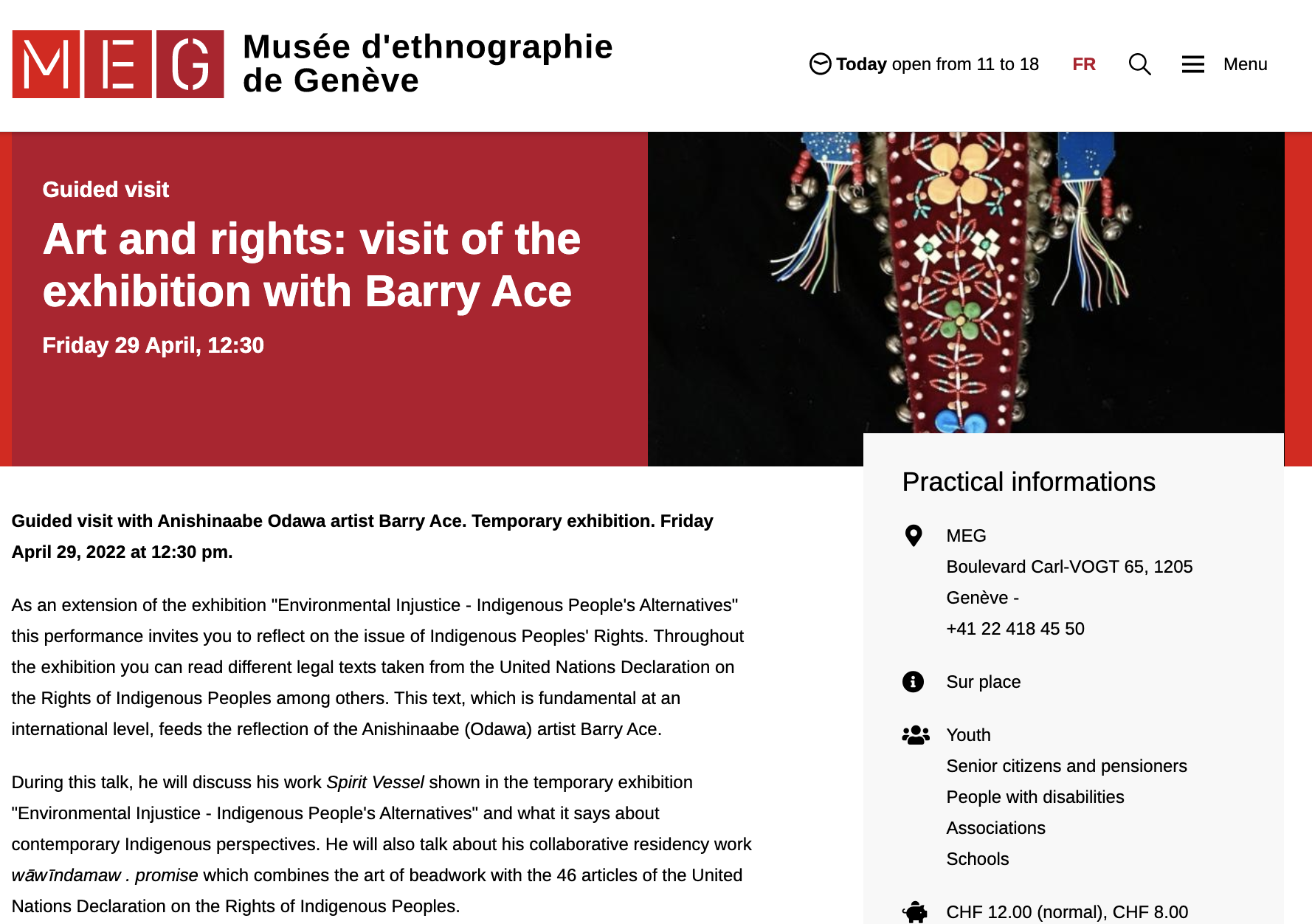 MEG (Geneva) - Artist Talk and UNDRIP Workshop
MEG (Geneva) - Artist Talk and UNDRIP Workshop 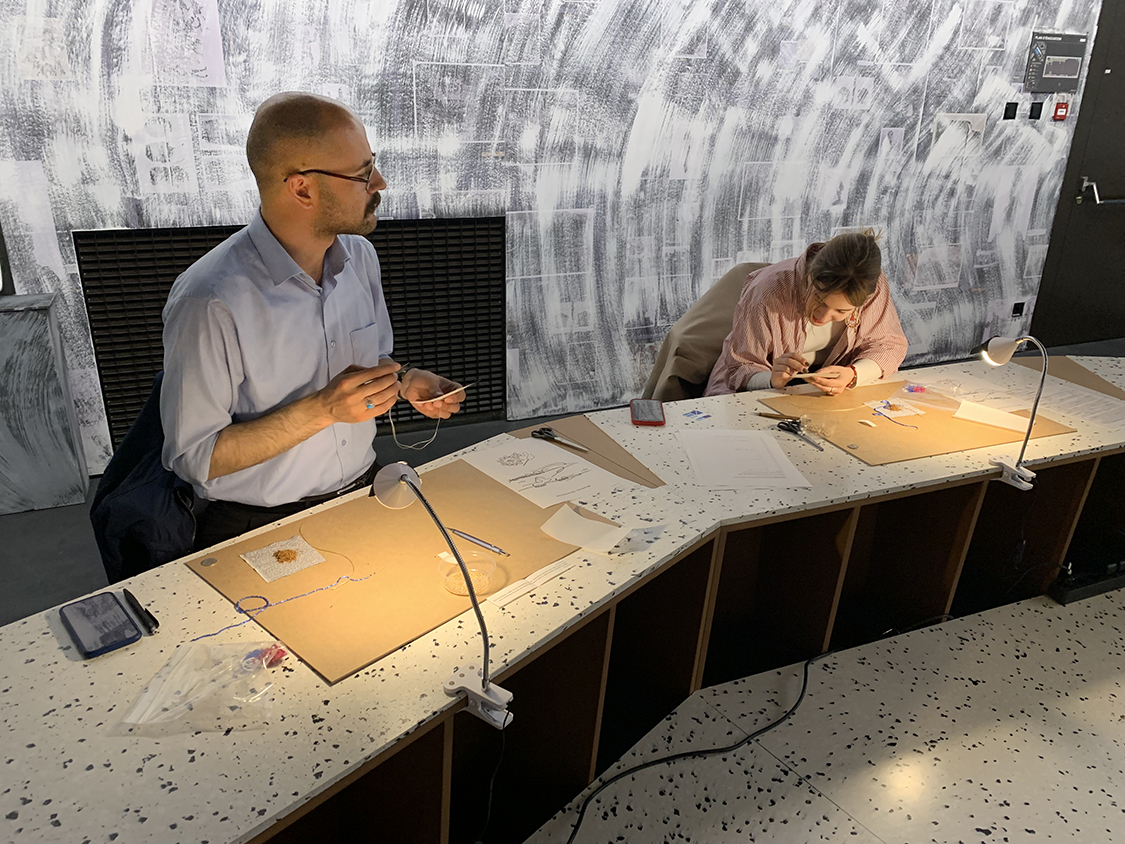 waawiindmawaa – promise (to promise something to somebody) workshop participants working on medallions and reading UNDRIP Articles (MEG, Geneva). April 27, 2022
waawiindmawaa – promise (to promise something to somebody) workshop participants working on medallions and reading UNDRIP Articles (MEG, Geneva). April 27, 2022 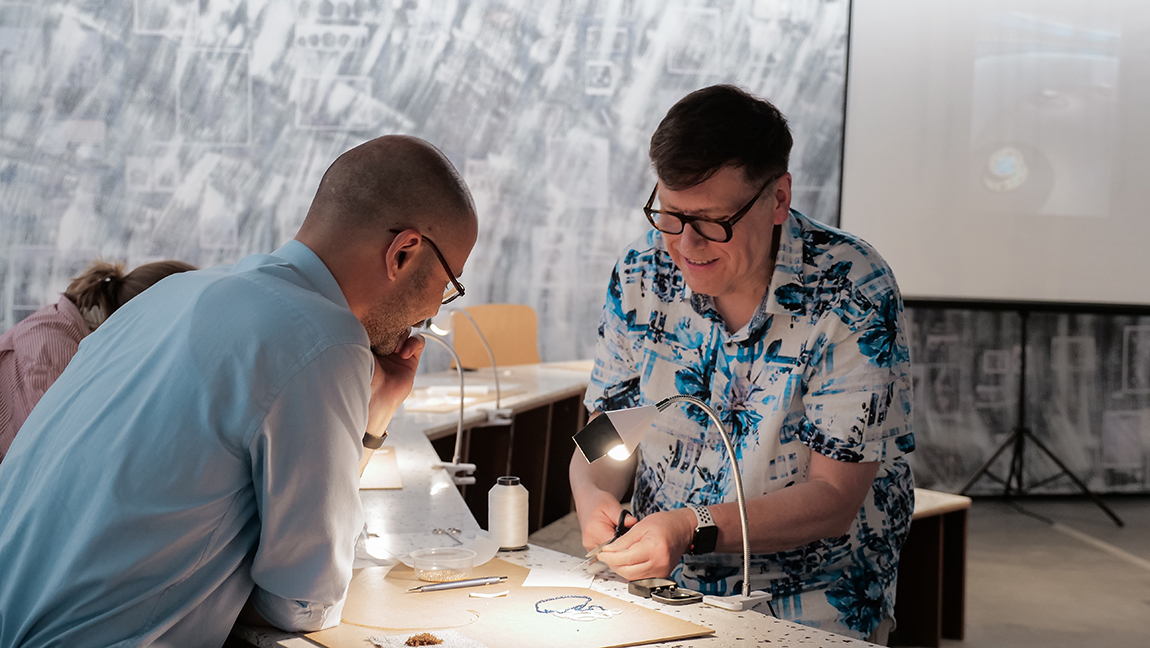 Photo Courtesy: MEG / Nicolas Seguel-Eduardo
Photo Courtesy: MEG / Nicolas Seguel-Eduardo 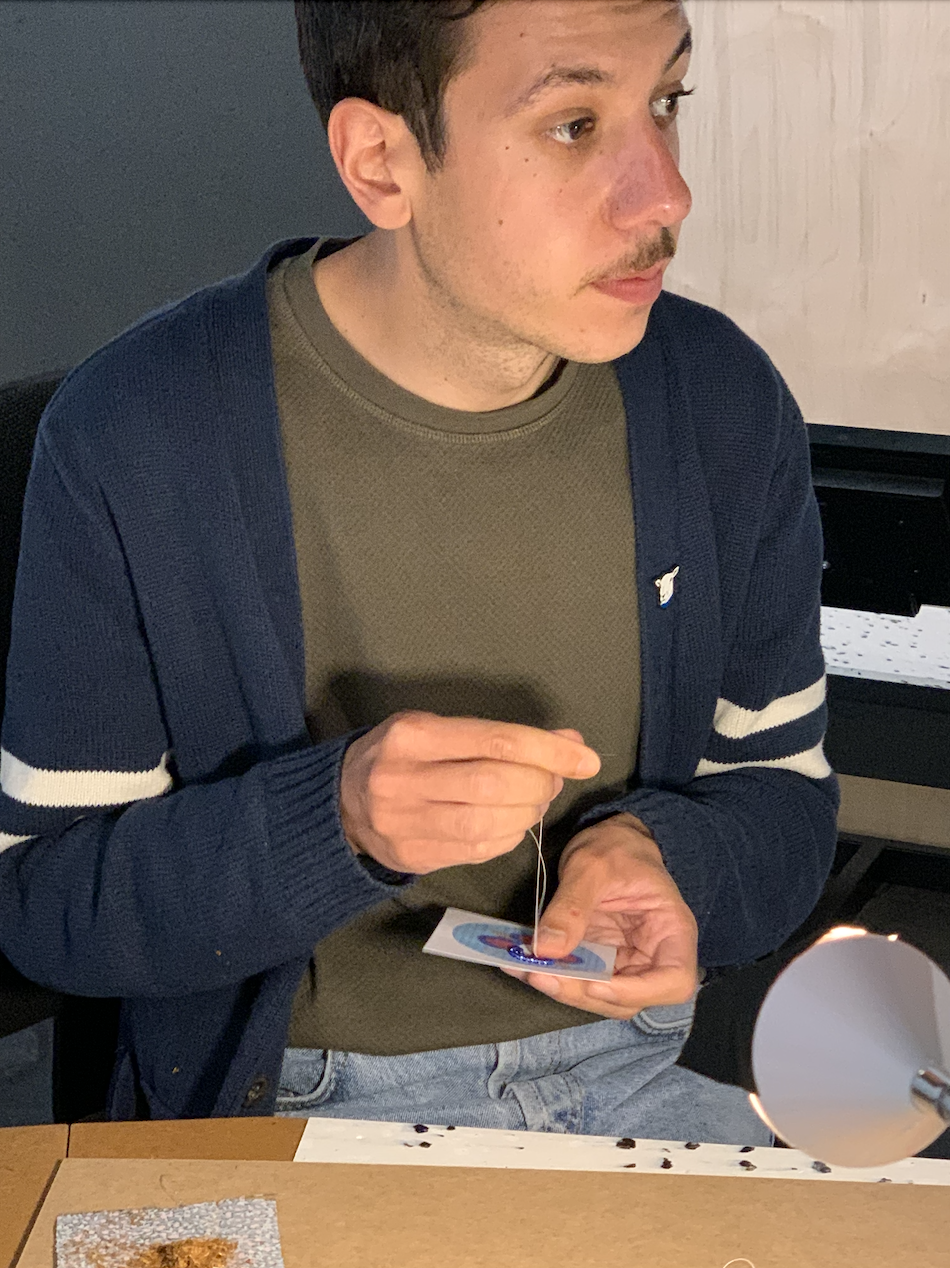 waawiindmawaa – promise (to promise something to somebody) workshop participants working on medallions and UNDRIP Articles (MEG, Geneva). April 27, 2022
waawiindmawaa – promise (to promise something to somebody) workshop participants working on medallions and UNDRIP Articles (MEG, Geneva). April 27, 2022 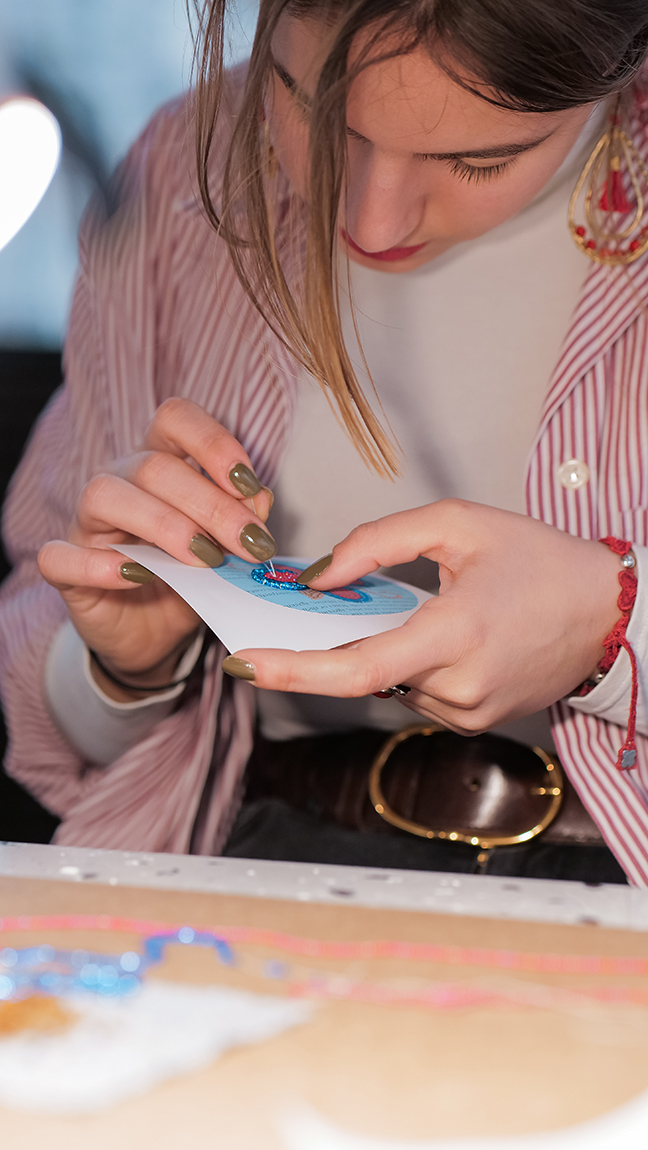 Photo Courtesy: MEG / Nicolas Seguel-Eduardo
Photo Courtesy: MEG / Nicolas Seguel-Eduardo 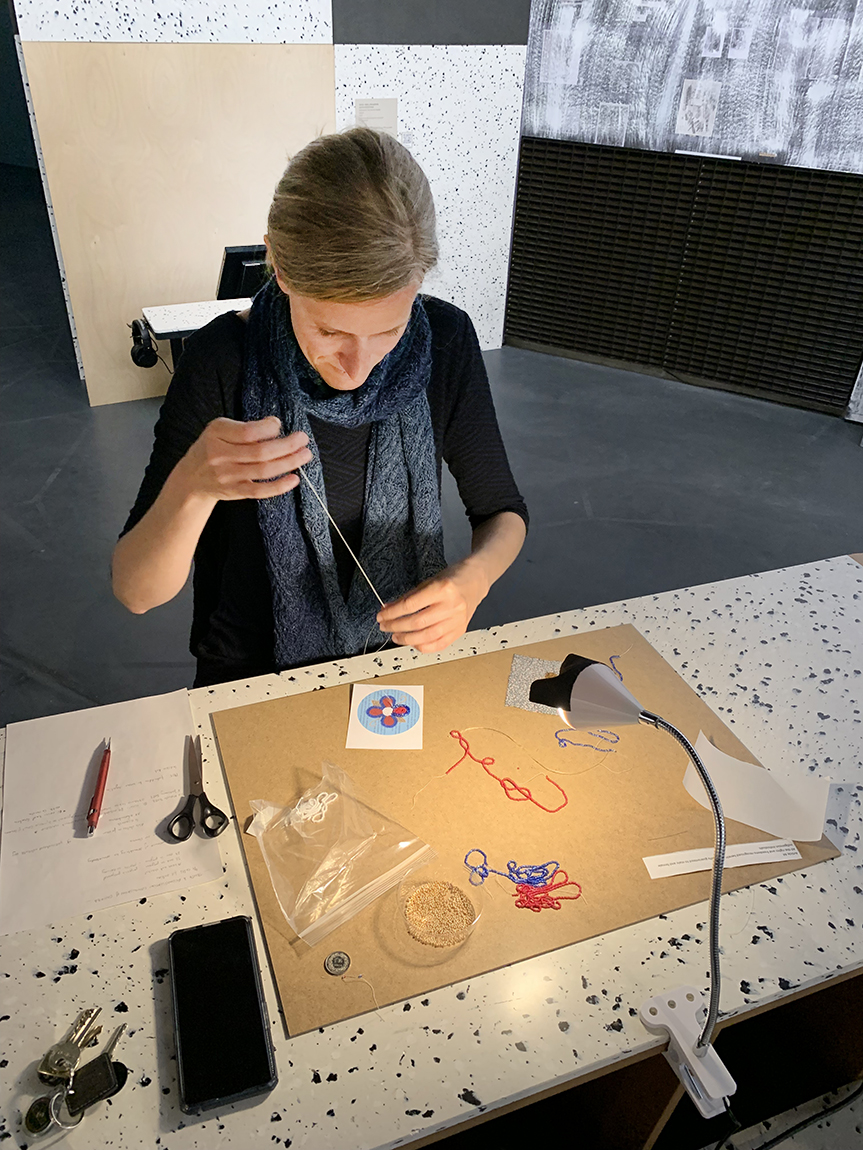 waawiindmawaa – promise (to promise something to somebody) workshop participants working on medallions and UNDRIP Articles (MEG, Geneva). April 27, 2022
waawiindmawaa – promise (to promise something to somebody) workshop participants working on medallions and UNDRIP Articles (MEG, Geneva). April 27, 2022 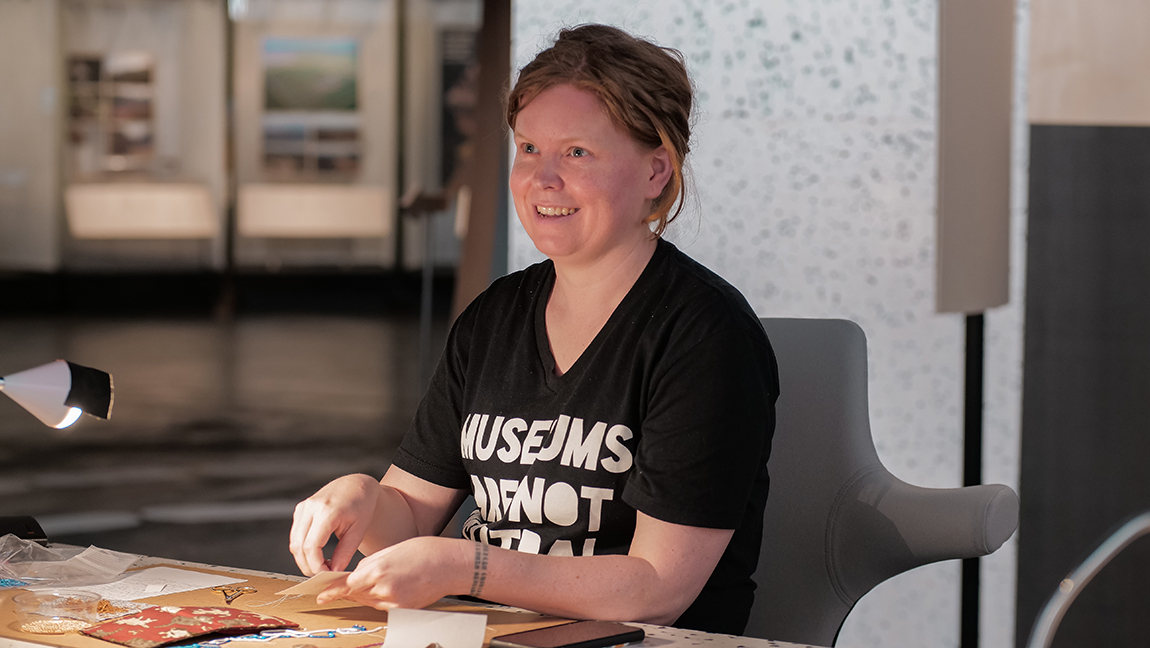 Photo Courtesy: MEG / Nicolas Seguel-Eduardo
Photo Courtesy: MEG / Nicolas Seguel-Eduardo 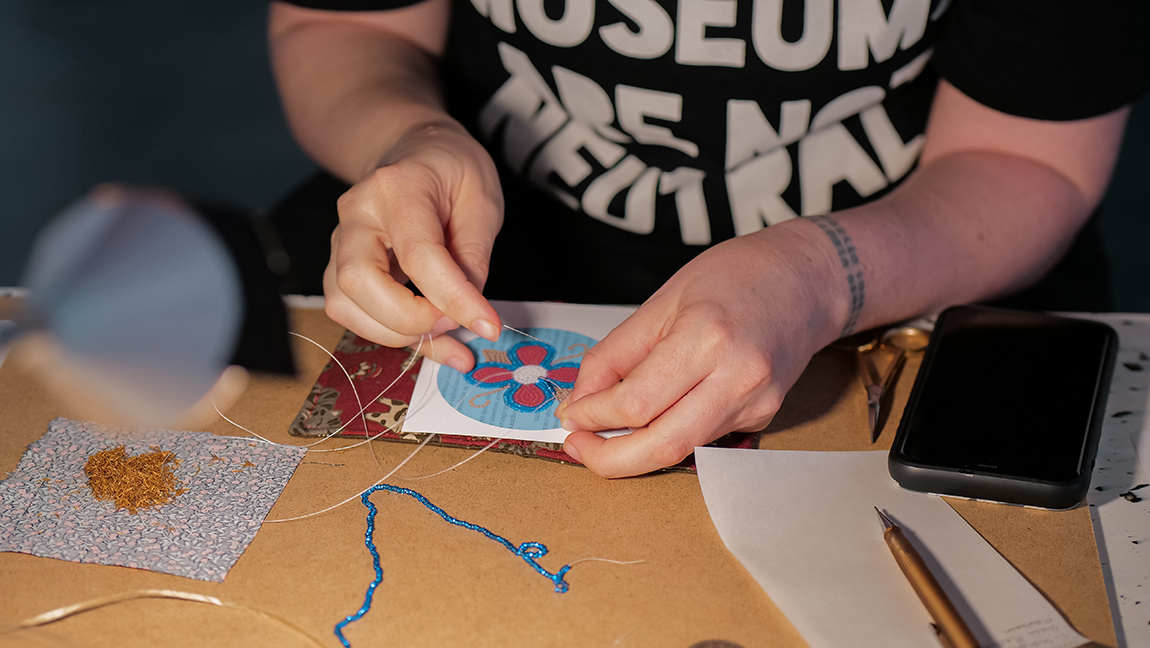 Photo Courtesy: MEG / Nicolas Seguel-Eduardo
Photo Courtesy: MEG / Nicolas Seguel-Eduardo 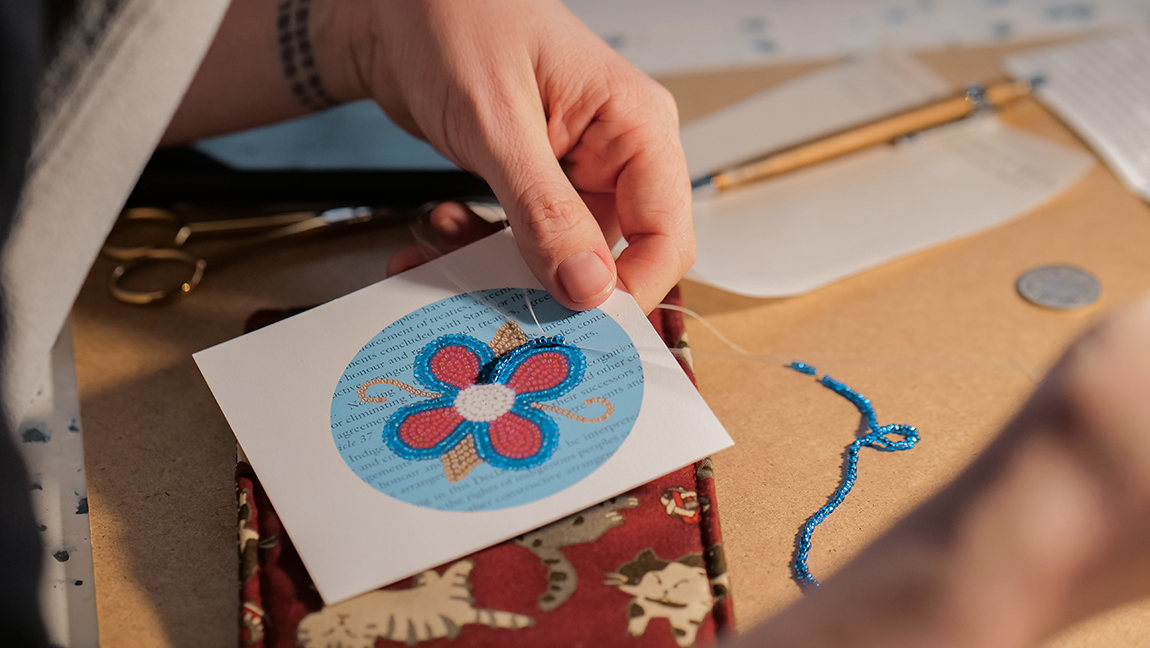 Photo Courtesy: MEG / Nicolas Seguel-Eduardo
Photo Courtesy: MEG / Nicolas Seguel-Eduardo 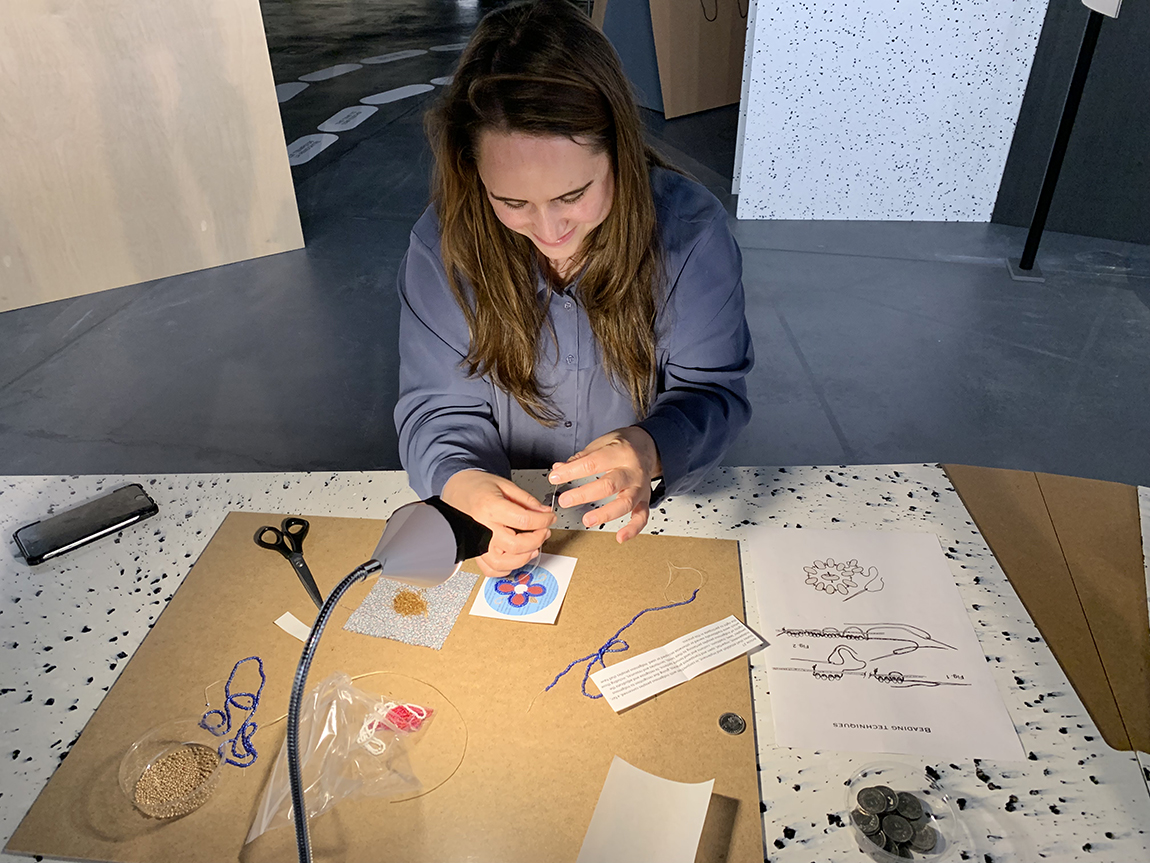 waawiindmawaa – promise (to promise something to somebody) workshop participants working on medallions and UNDRIP Articles (MEG, Geneva). April 27, 2022
waawiindmawaa – promise (to promise something to somebody) workshop participants working on medallions and UNDRIP Articles (MEG, Geneva). April 27, 2022 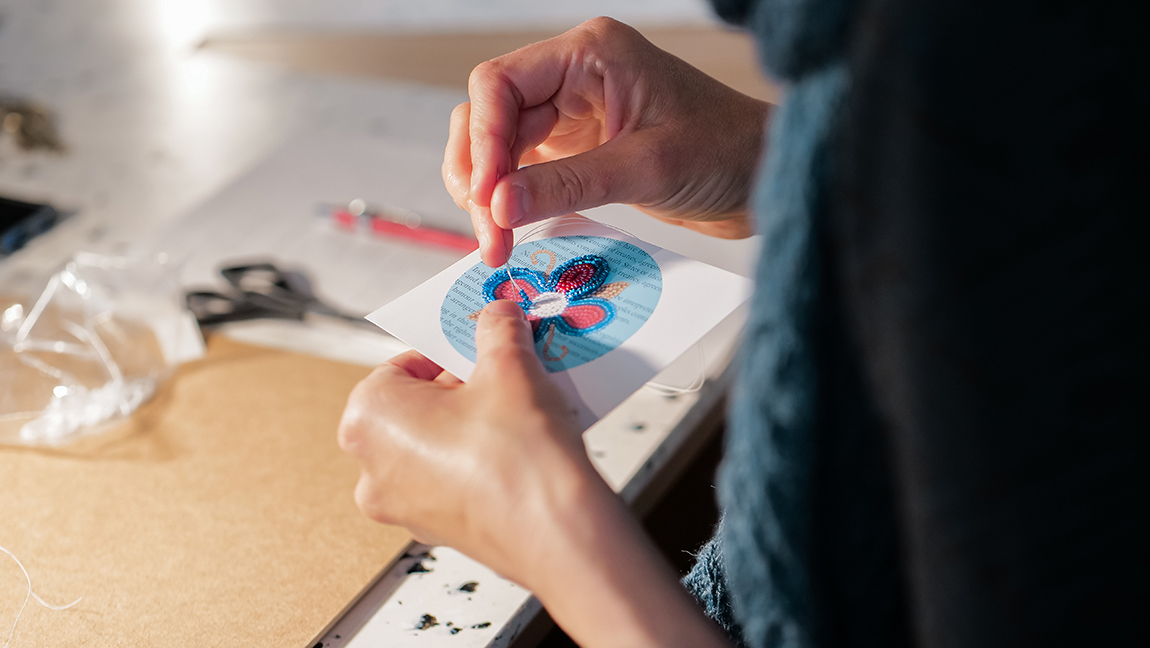 Photo Courtesy: MEG / Nicolas Seguel-Eduardo
Photo Courtesy: MEG / Nicolas Seguel-Eduardo 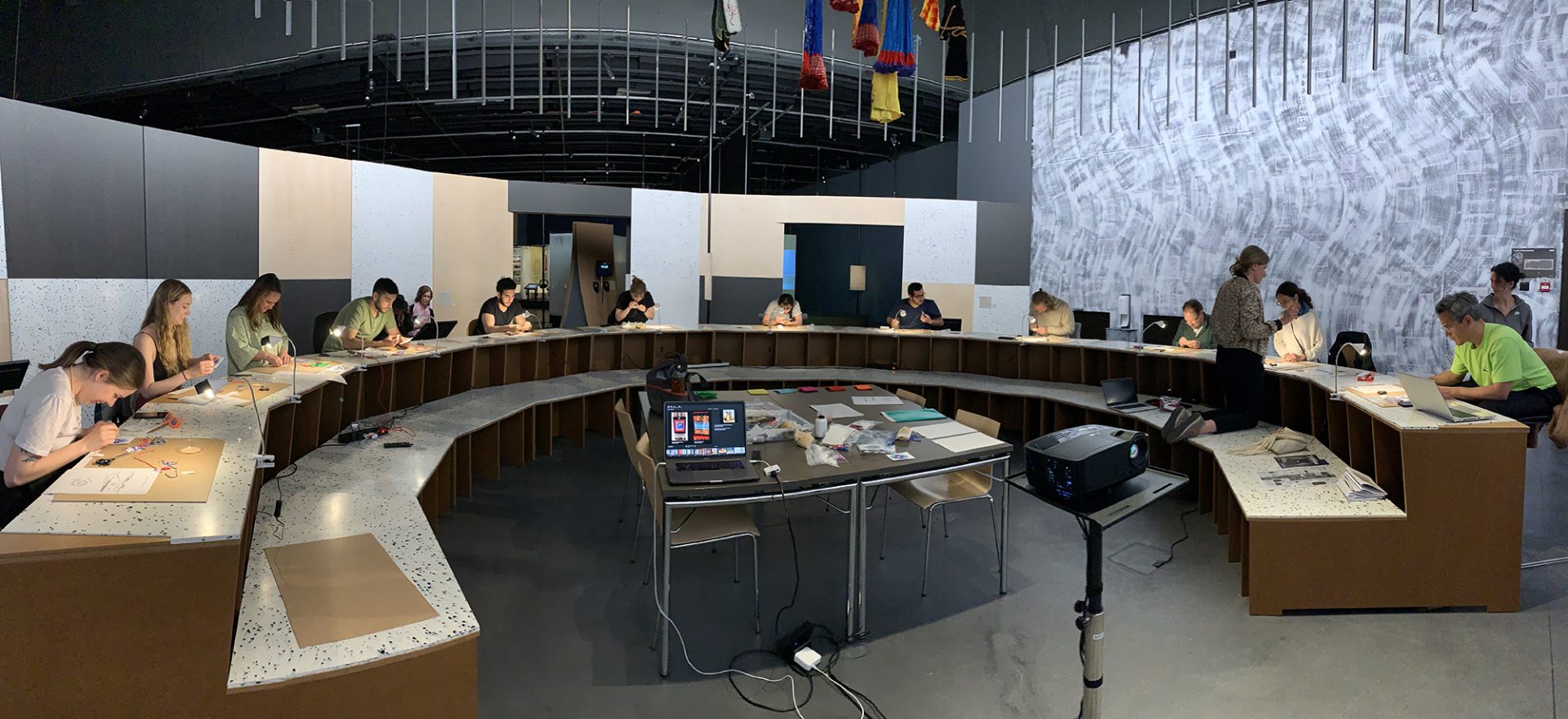 waawiindmawaa – promise (to promise something to somebody) workshop participants working on medallions and UNDRIP Articles (MEG, Geneva). April 28, 2022
waawiindmawaa – promise (to promise something to somebody) workshop participants working on medallions and UNDRIP Articles (MEG, Geneva). April 28, 2022 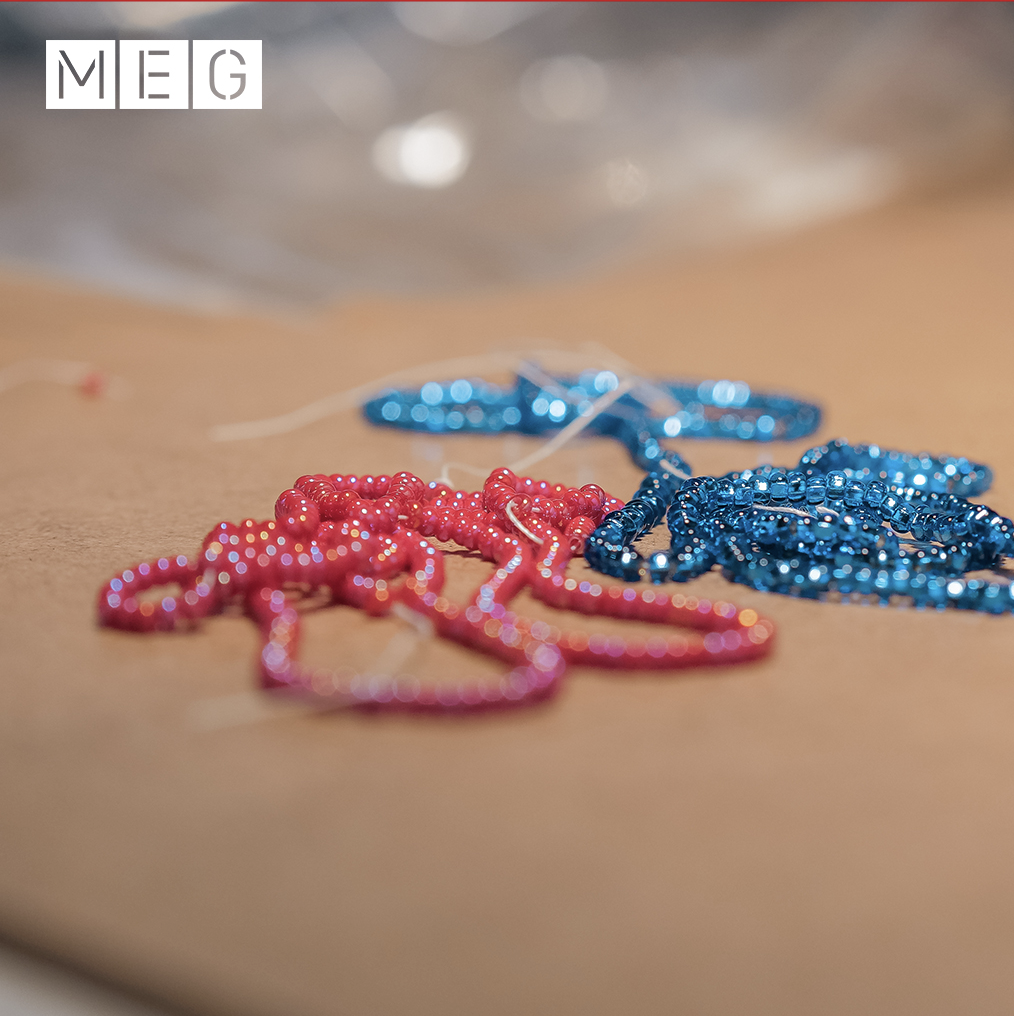 Manidoominens (Little Spirits). Photo Courtesy: MEG / Nicolas Seguel-Eduardo
Manidoominens (Little Spirits). Photo Courtesy: MEG / Nicolas Seguel-Eduardo  Monday, April 25, 2022 (New York, USA). AFN national chief asks UN to investigate Canada's role in residential schools
Monday, April 25, 2022 (New York, USA). AFN national chief asks UN to investigate Canada's role in residential schools 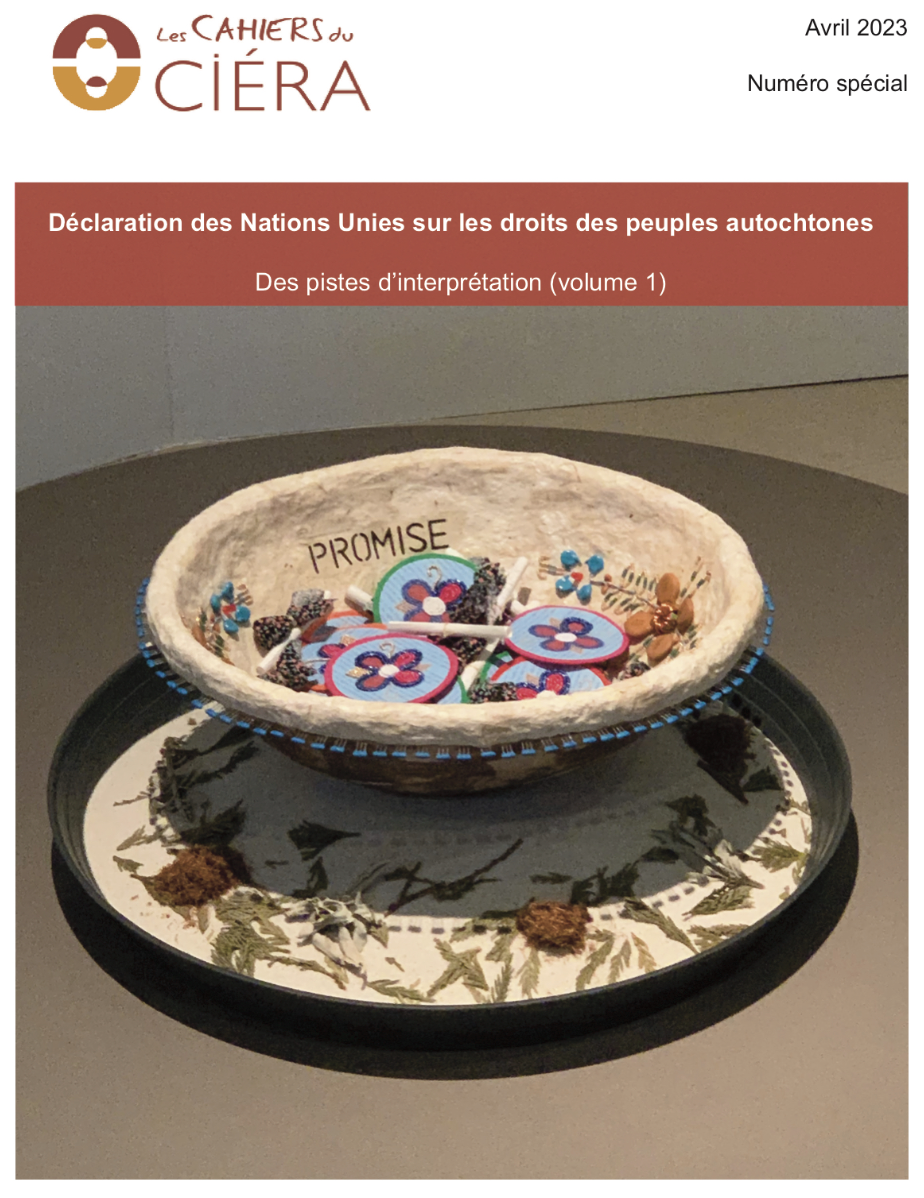 Cover for Les Cahiers du CIÉRA
Cover for Les Cahiers du CIÉRA